 During last week's Valley of the Mastodons events, museum supporter Doug Shore donated a collection of invertebrate and plant fossils to Western Science Center. Several of Doug's specimens come from Mason Creek, an incredibly rich Carboniferous site in Illinois that is most famous for its beautiful fossil plants. While WSC has a large collection of Mason Creek plants, we did not have any of the numerous animals also found at the site until now.Above are two specimens of the mollusk Aviculopecten mazonensis, a scallop. At least, I think it's two specimens. As the name states, bivalve mollusk have two valves or shells. In many bivalves these two shells look quite different from each other, but in the pectinids (scallops) they are often very similar (although one valve tends to be deeper than the other). In this case the two valves have slightly different dimensions and both seem to have the same curvature, making me suspect they represent two individuals rather than two shells from one individual. Thanks to Doug for this nice addition to the WSC collection!
During last week's Valley of the Mastodons events, museum supporter Doug Shore donated a collection of invertebrate and plant fossils to Western Science Center. Several of Doug's specimens come from Mason Creek, an incredibly rich Carboniferous site in Illinois that is most famous for its beautiful fossil plants. While WSC has a large collection of Mason Creek plants, we did not have any of the numerous animals also found at the site until now.Above are two specimens of the mollusk Aviculopecten mazonensis, a scallop. At least, I think it's two specimens. As the name states, bivalve mollusk have two valves or shells. In many bivalves these two shells look quite different from each other, but in the pectinids (scallops) they are often very similar (although one valve tends to be deeper than the other). In this case the two valves have slightly different dimensions and both seem to have the same curvature, making me suspect they represent two individuals rather than two shells from one individual. Thanks to Doug for this nice addition to the WSC collection!
Valley of the Mastodons
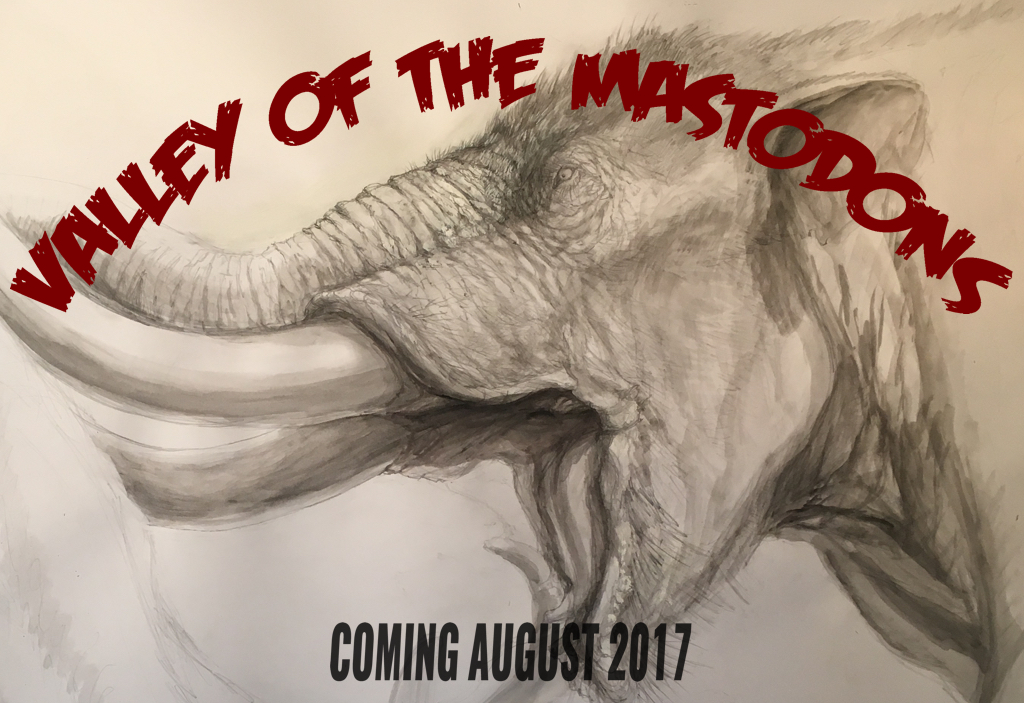 I missed doing a Fossil Friday post last week. But my reason was a good one: that was the opening day for our new exhibit, Valley of the Mastodons!Valley of the Mastodons was more than just an exhibit, however. It started with a 3-day symposium with 17 scientists and science communicators from the US and Canada examining the WSC mastodon collection, giving presentations, engaging with the public, and helping with the exhibit. Besides being what we believe to be the largest exhibit of mastodons in history, we're attempting to break new ground in making the act of research itself part of outreach, in real time.We had pretty good media exposure, with more to come:KTLA 5PLOS Paleo CommunityThe Press-EnterpriseSauropod Vertebra Picture of the WeekDontmesswithdinosaurs.comI'll have lots more to say about Valley of the Mastodons in the future, including at the Society of Vertebrate Paleontology in Calgary later this month. But for now I want to thank our sponsors and supporters Golden Village Palms RV Resort, Abbott Vascular, Bone Clones, and Brian Engh Paleoart, as well as the participants that made this event such a success! Below are bunches of pictures from the event:
I missed doing a Fossil Friday post last week. But my reason was a good one: that was the opening day for our new exhibit, Valley of the Mastodons!Valley of the Mastodons was more than just an exhibit, however. It started with a 3-day symposium with 17 scientists and science communicators from the US and Canada examining the WSC mastodon collection, giving presentations, engaging with the public, and helping with the exhibit. Besides being what we believe to be the largest exhibit of mastodons in history, we're attempting to break new ground in making the act of research itself part of outreach, in real time.We had pretty good media exposure, with more to come:KTLA 5PLOS Paleo CommunityThe Press-EnterpriseSauropod Vertebra Picture of the WeekDontmesswithdinosaurs.comI'll have lots more to say about Valley of the Mastodons in the future, including at the Society of Vertebrate Paleontology in Calgary later this month. But for now I want to thank our sponsors and supporters Golden Village Palms RV Resort, Abbott Vascular, Bone Clones, and Brian Engh Paleoart, as well as the participants that made this event such a success! Below are bunches of pictures from the event: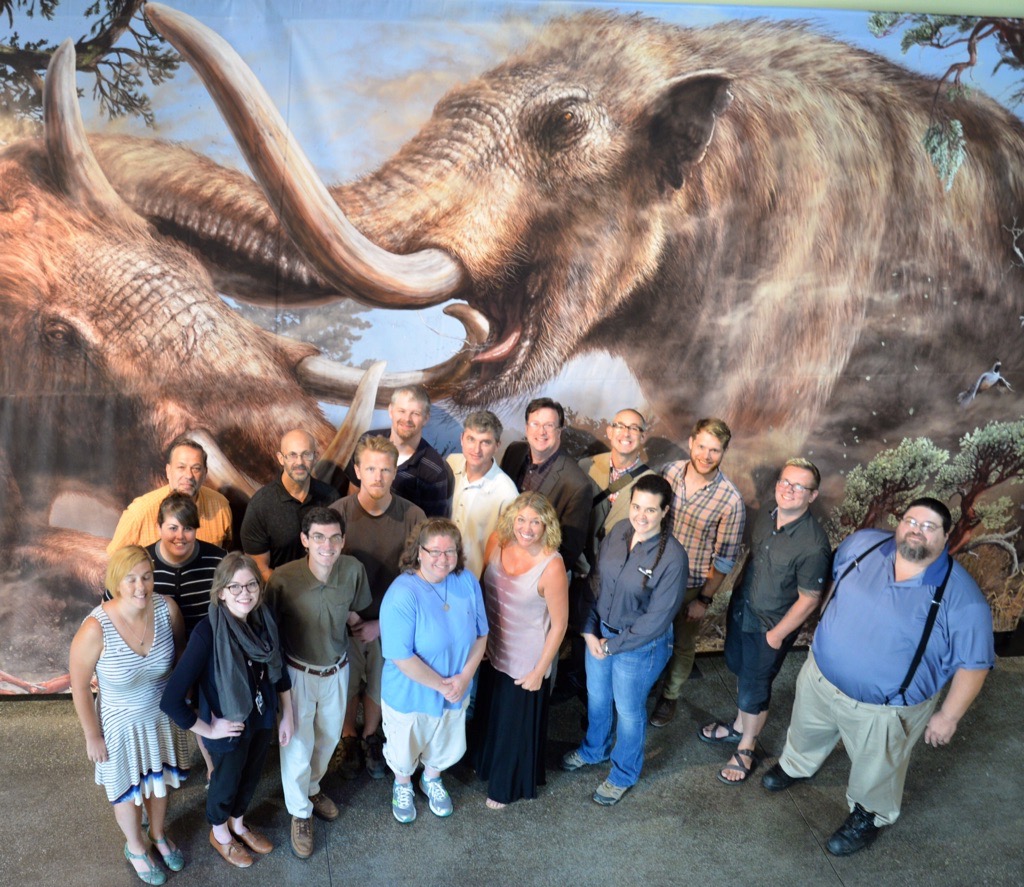
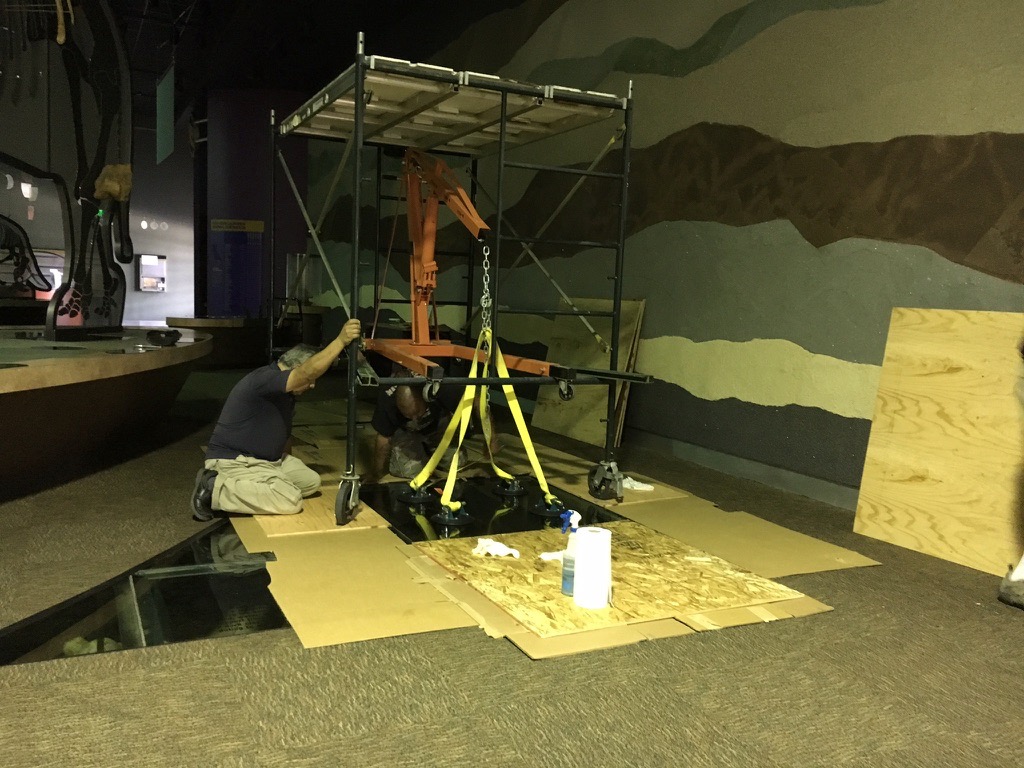
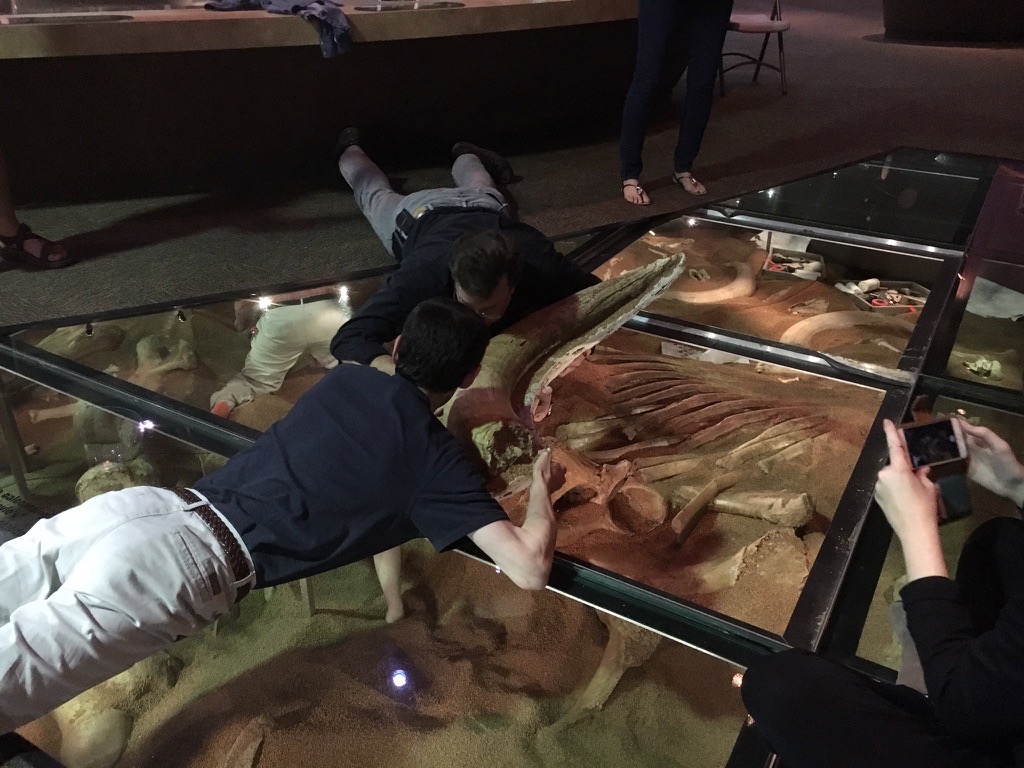
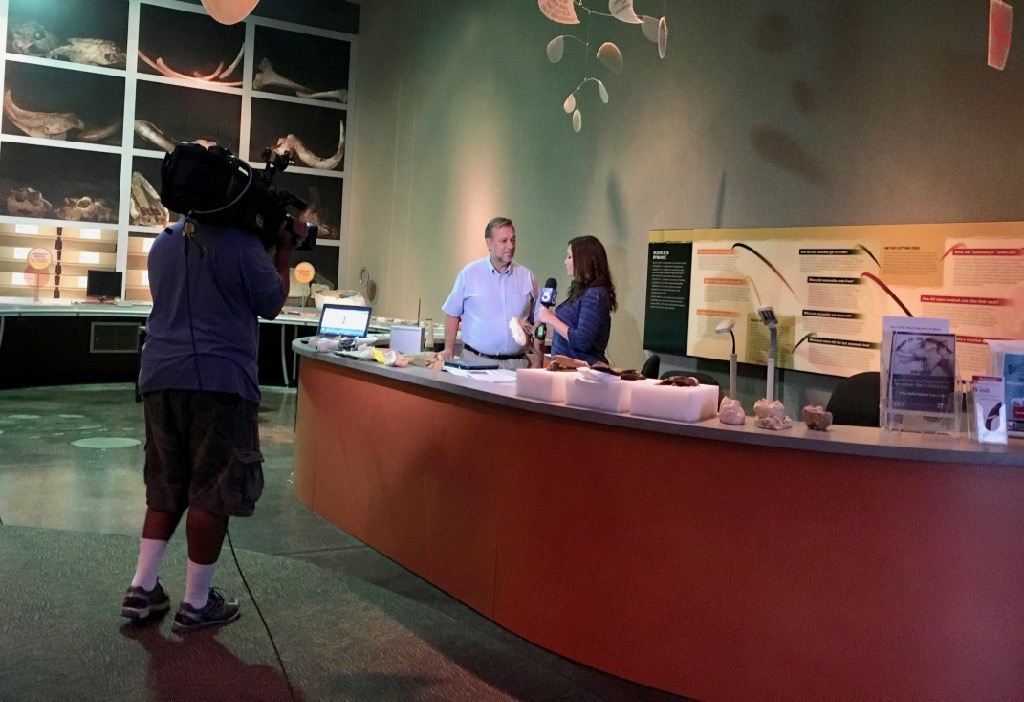
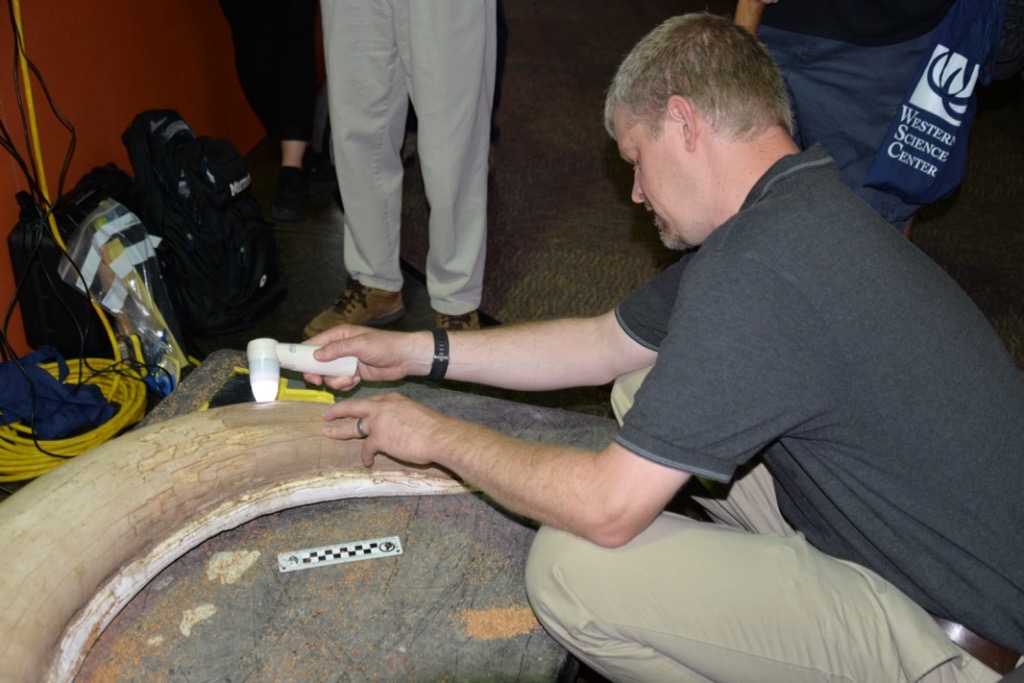
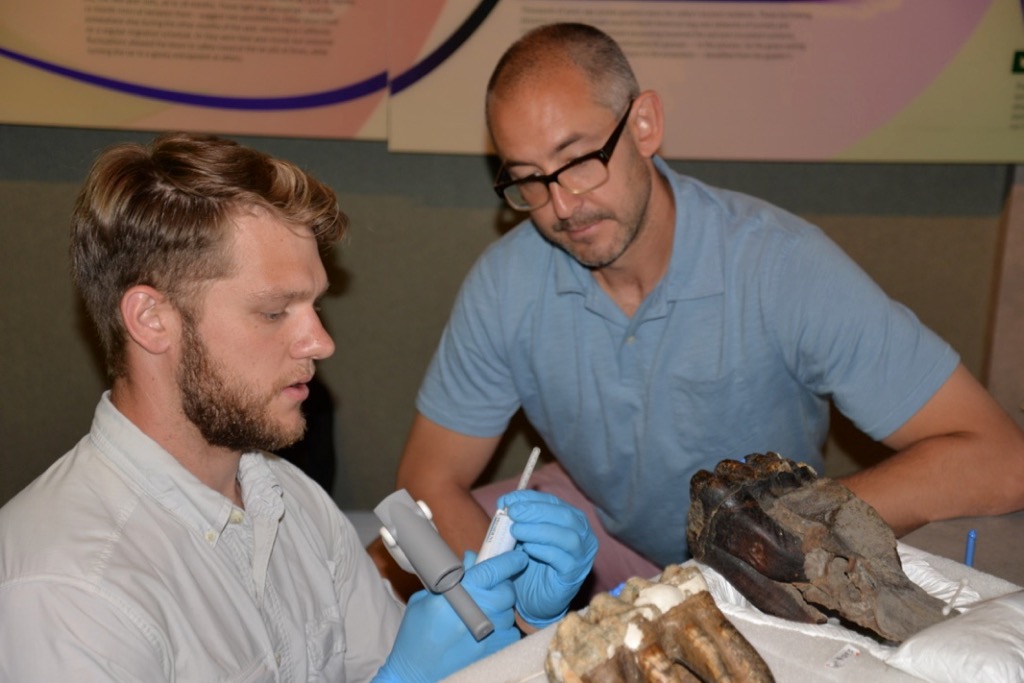
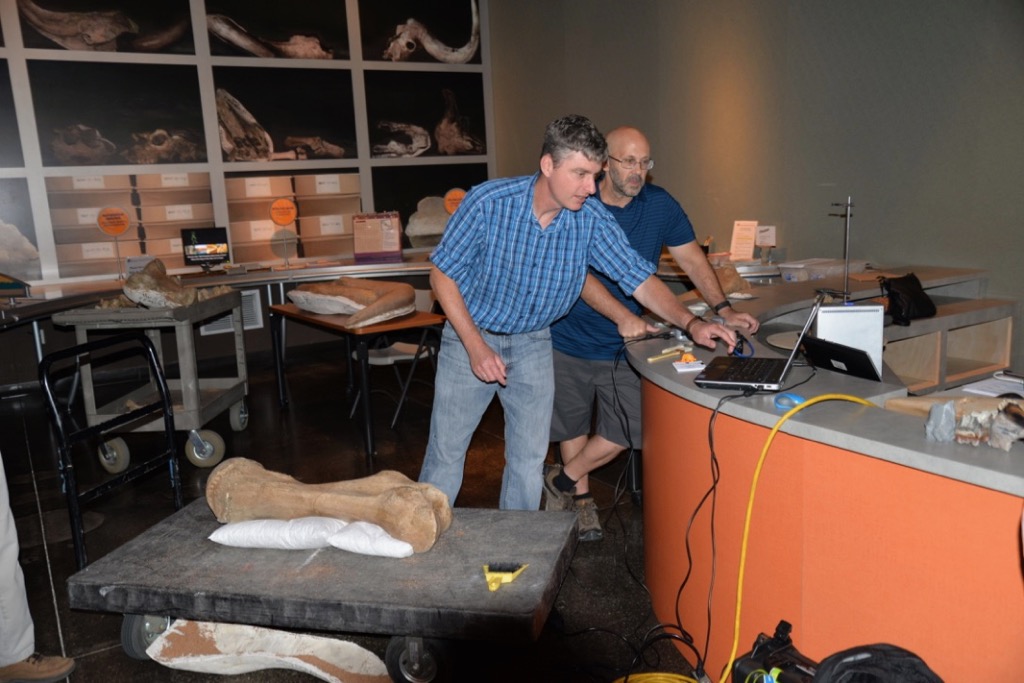
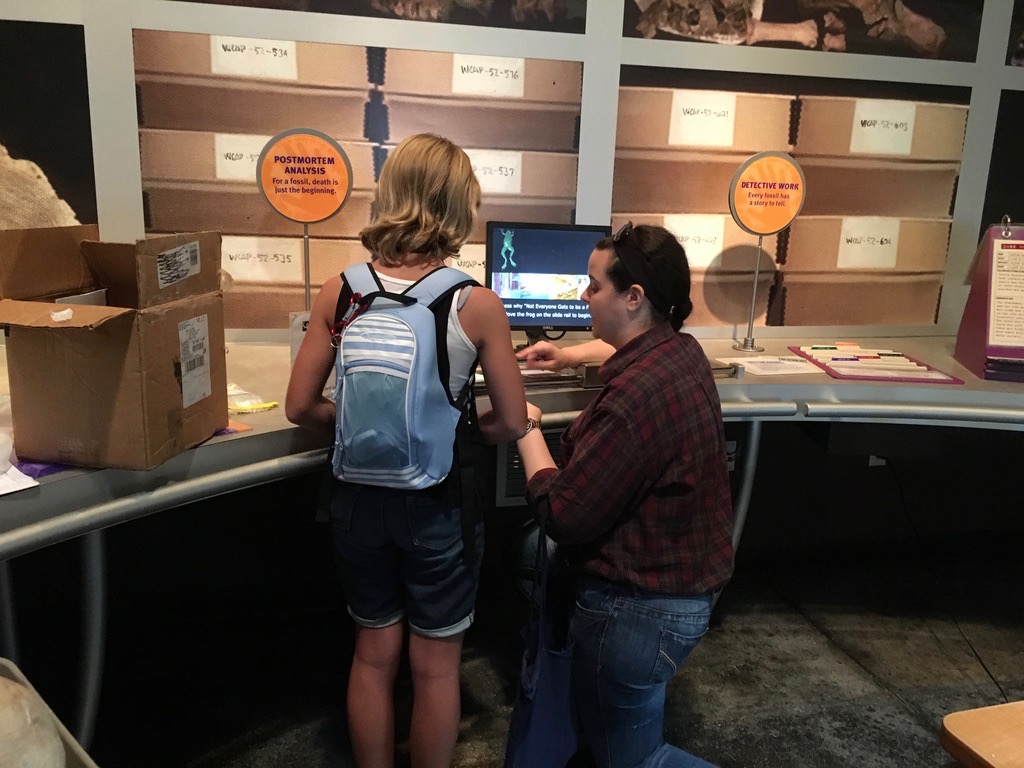
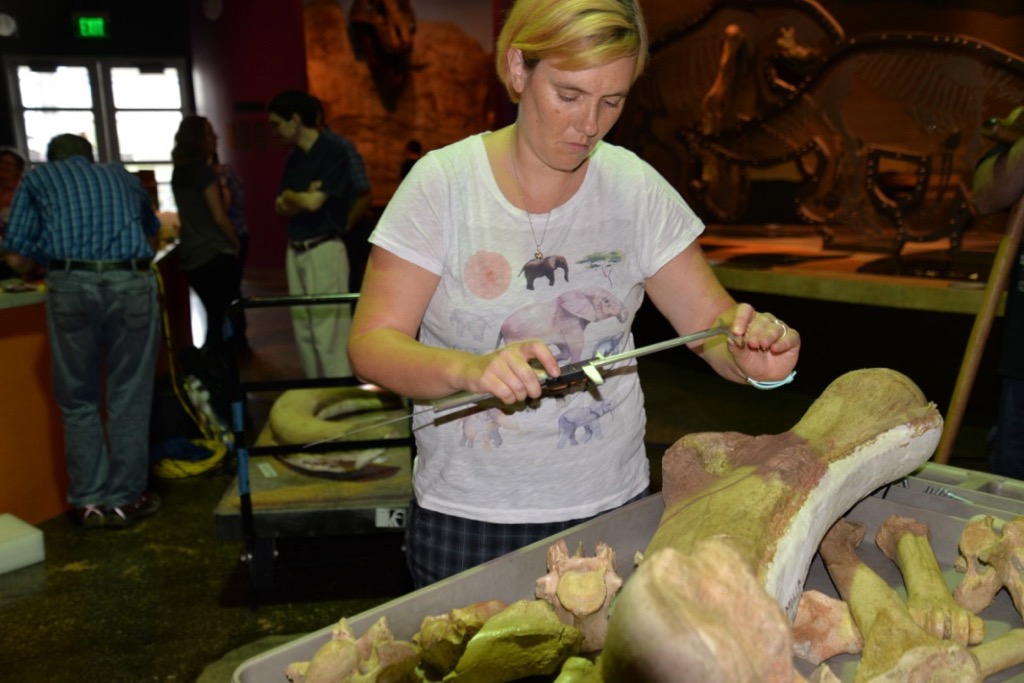
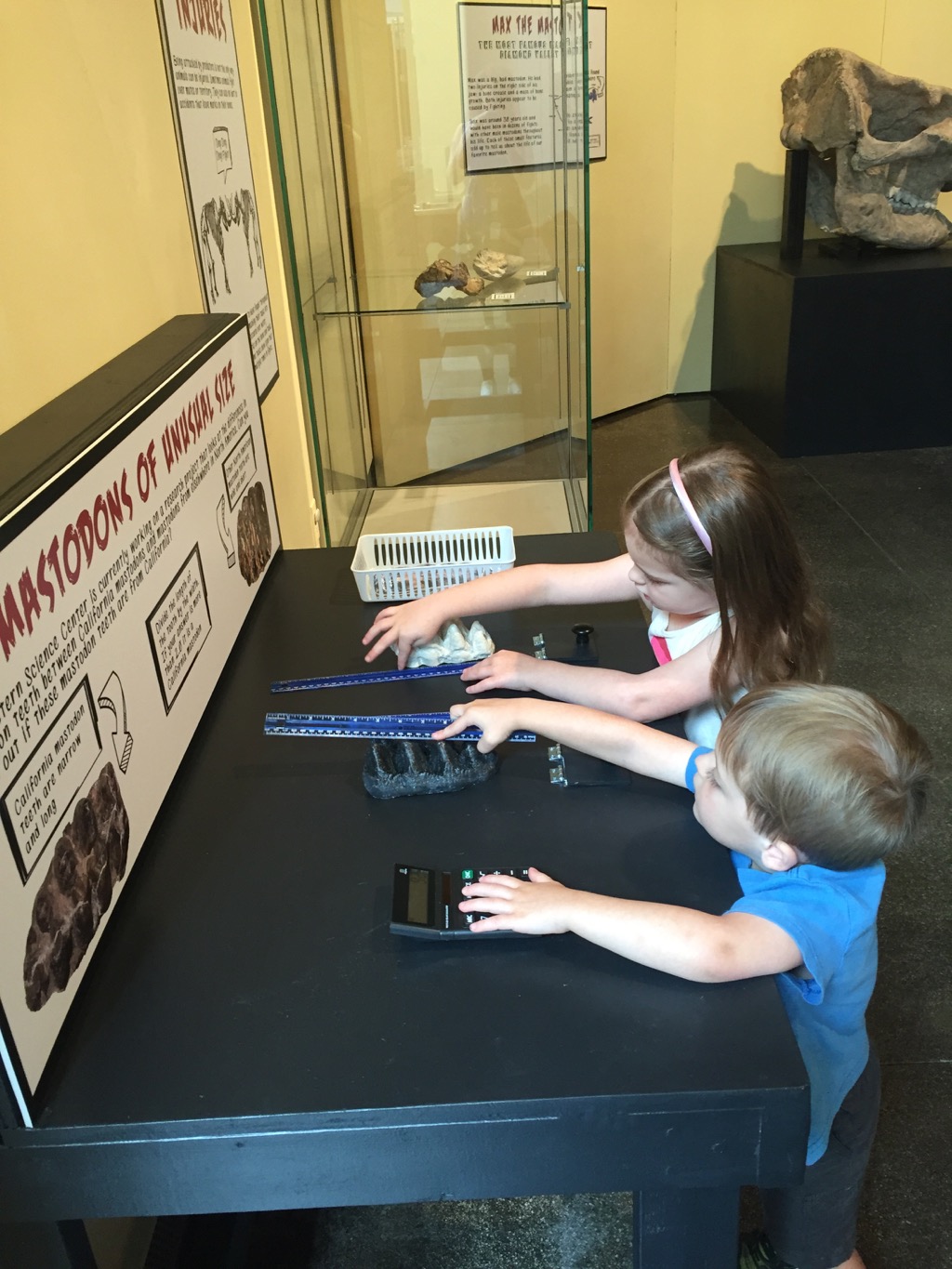
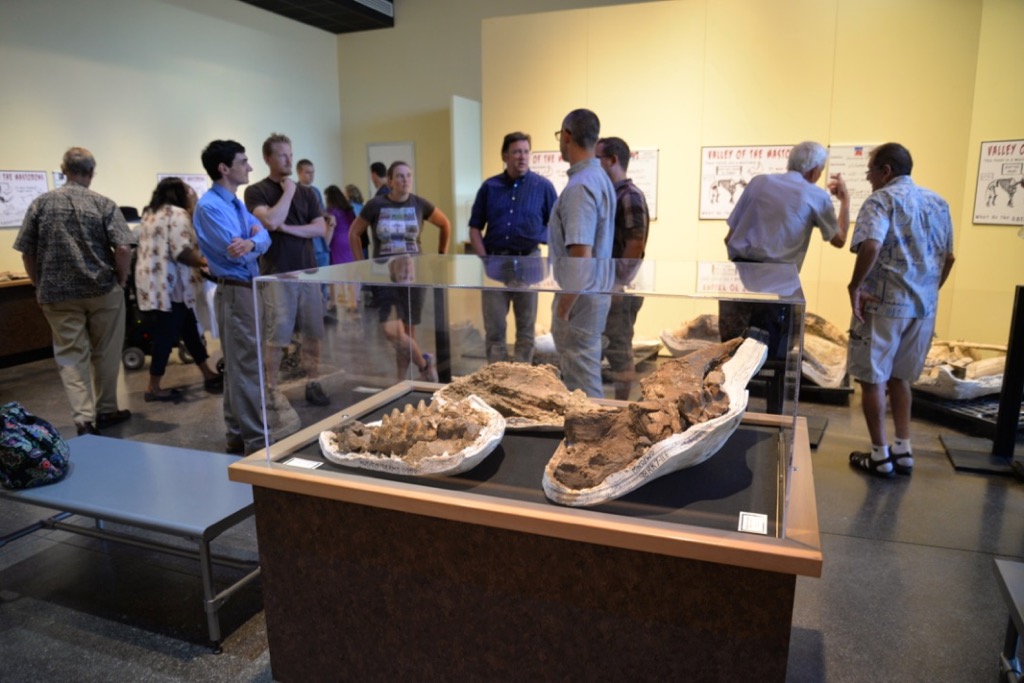
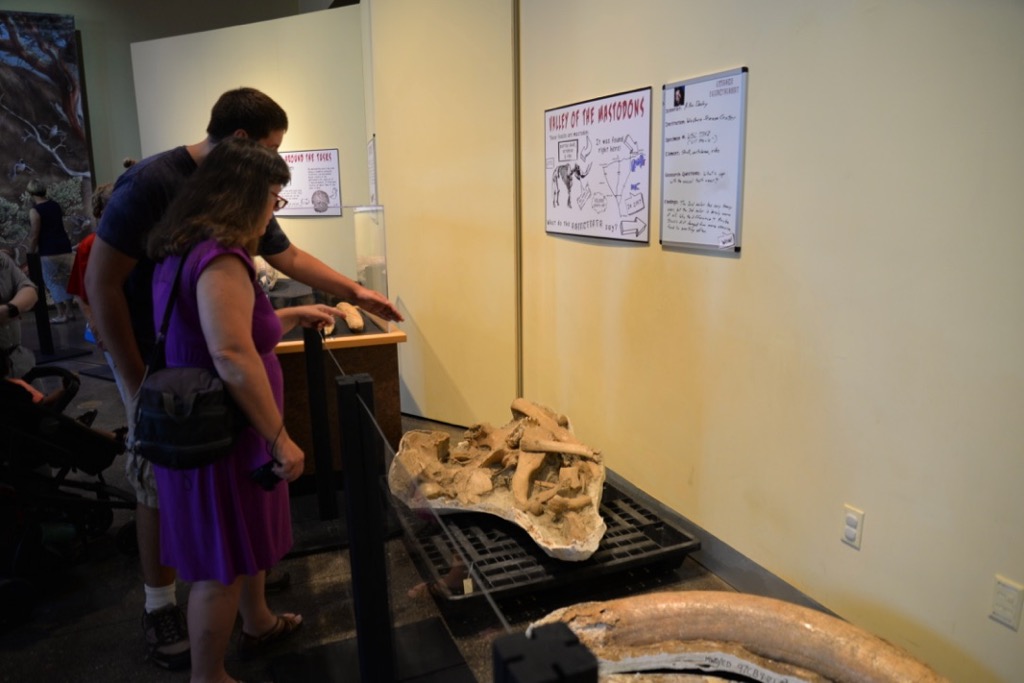
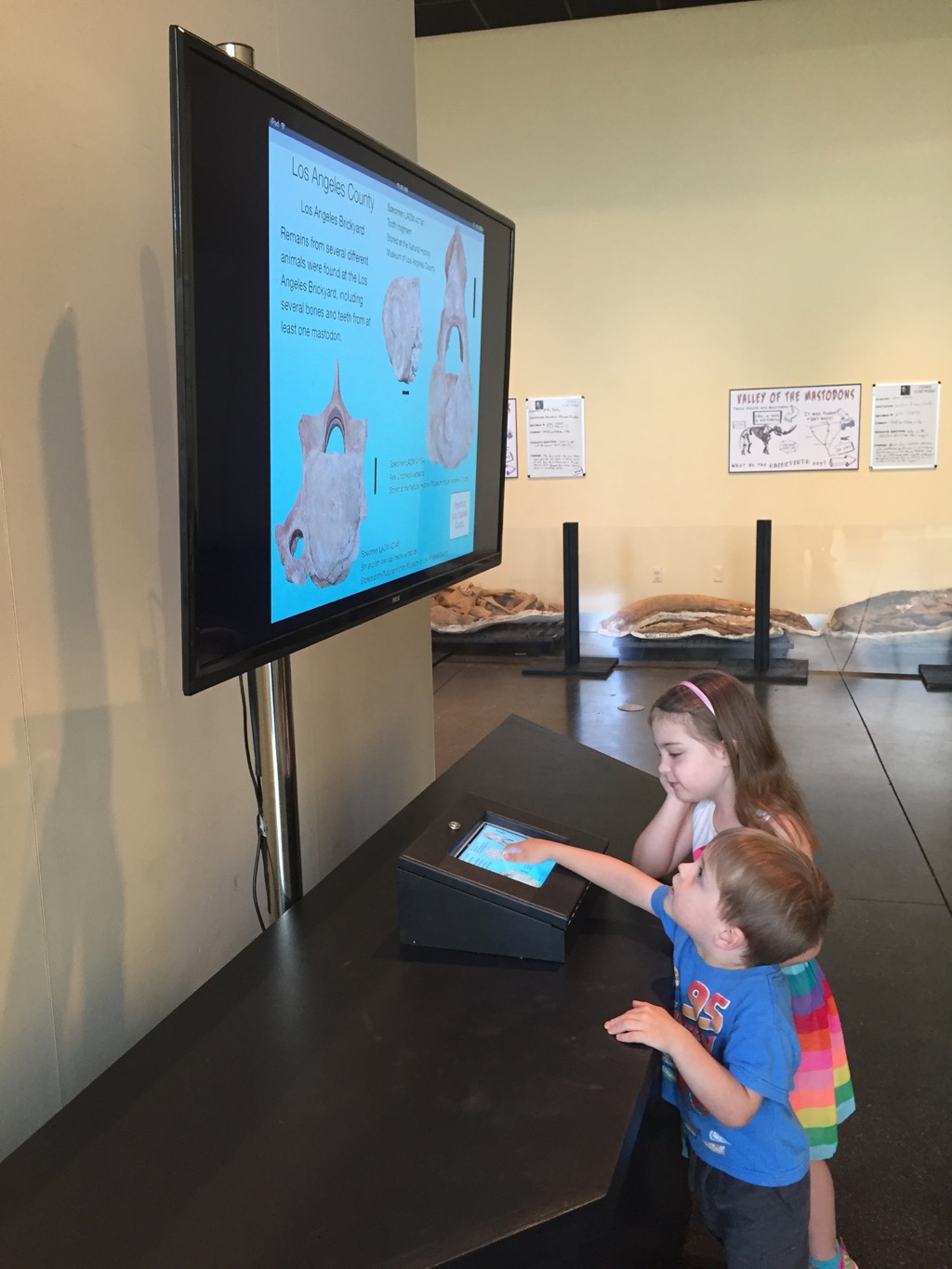
Fossil Friday - mastodon tusks
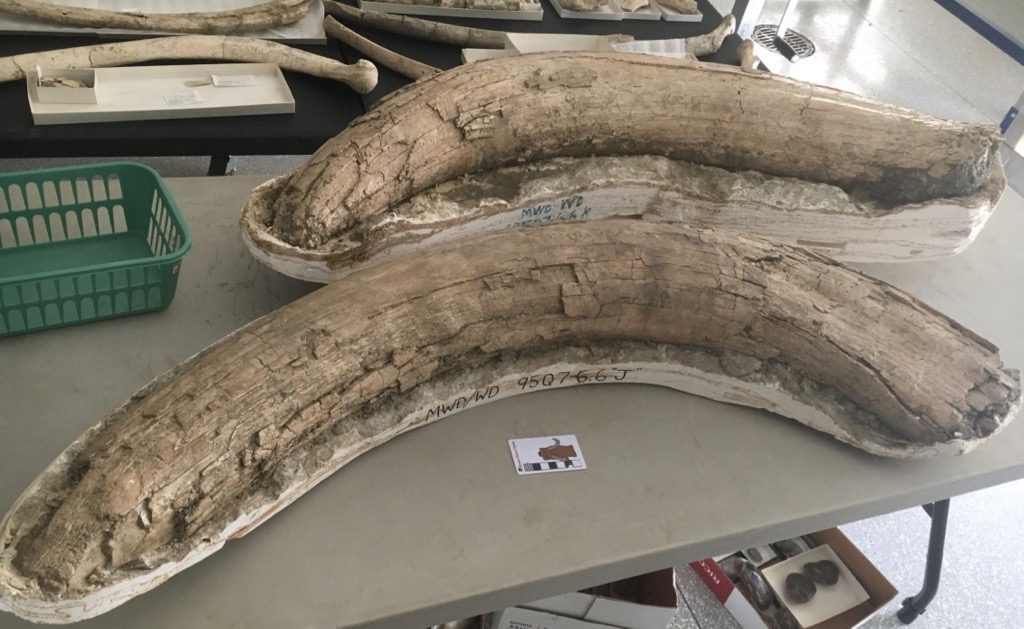 In three days scientists start arriving in Hemet for the Valley of the Mastodons symposium, and we're one week from the opening of the associated Valley of the Mastodons exhibit. As a result, I'm a little swamped, and today's Fossil Friday post will have to be brief.The original plan for Valley of the Mastodons was to display all of the mastodon material recovered from Diamond Valley Lake. That plan didn't last long. Our temporary exhibit gallery is 3,000 square feet, and while that's a pretty big room, we have a LOT of mastodons! It didn't take long to realize that they won't all fit. So we had to triage the collection, and things that have really cruddy preservation, and isolated bones that we can't say much about, are not going on display.One of the specimens that did make the cut is a partial mastodon from the West Dam, the area with the highest concentration of mastodons. This partial skeleton includes several ribs and vertebrae (a few weeks ago I featured its axis vertebra), a lower jaw fragment, a humerus, and both tusks. The tusks are shown above. They're reasonably well preserved, and include the open pulp cavities at the proximal ends (filled with sediment). The tips had crumbled a bit and are incomplete, but it doesn't look like too much is missing. The size of these tusks indicate that this was an adult male mastodon, although the unfused epiphyses on several vertebrae show that it wasn't quite finished growing.This mastodon and more than a dozen others will be on display beginning August 5 (WSC members are invited to a preview showing on August 4).
In three days scientists start arriving in Hemet for the Valley of the Mastodons symposium, and we're one week from the opening of the associated Valley of the Mastodons exhibit. As a result, I'm a little swamped, and today's Fossil Friday post will have to be brief.The original plan for Valley of the Mastodons was to display all of the mastodon material recovered from Diamond Valley Lake. That plan didn't last long. Our temporary exhibit gallery is 3,000 square feet, and while that's a pretty big room, we have a LOT of mastodons! It didn't take long to realize that they won't all fit. So we had to triage the collection, and things that have really cruddy preservation, and isolated bones that we can't say much about, are not going on display.One of the specimens that did make the cut is a partial mastodon from the West Dam, the area with the highest concentration of mastodons. This partial skeleton includes several ribs and vertebrae (a few weeks ago I featured its axis vertebra), a lower jaw fragment, a humerus, and both tusks. The tusks are shown above. They're reasonably well preserved, and include the open pulp cavities at the proximal ends (filled with sediment). The tips had crumbled a bit and are incomplete, but it doesn't look like too much is missing. The size of these tusks indicate that this was an adult male mastodon, although the unfused epiphyses on several vertebrae show that it wasn't quite finished growing.This mastodon and more than a dozen others will be on display beginning August 5 (WSC members are invited to a preview showing on August 4).
Fossil Friday - mastodon jaw fragment
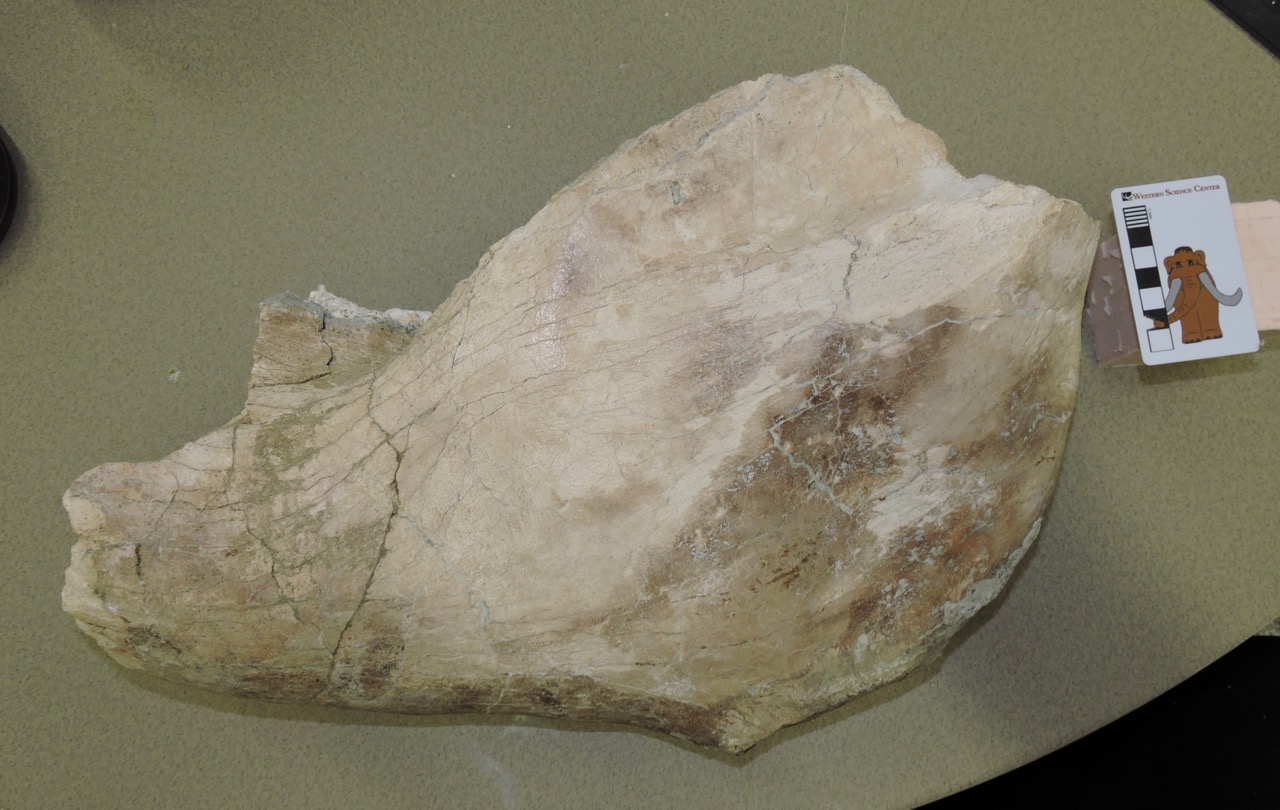 As we build up to our new exhibit opening, I'll continue the Month of Mastodons with a partial lower jaw.This is the back end of the left dentary, seen in lateral view with anterior to the left. The front half of the bone is missing, as are the coronoid process and condyle that should be located at the posterodorsal edge (upper right in the photo). The tooth crown is also broken. Below is a medial view of the same bone:
As we build up to our new exhibit opening, I'll continue the Month of Mastodons with a partial lower jaw.This is the back end of the left dentary, seen in lateral view with anterior to the left. The front half of the bone is missing, as are the coronoid process and condyle that should be located at the posterodorsal edge (upper right in the photo). The tooth crown is also broken. Below is a medial view of the same bone: And here's the dorsal view:
And here's the dorsal view: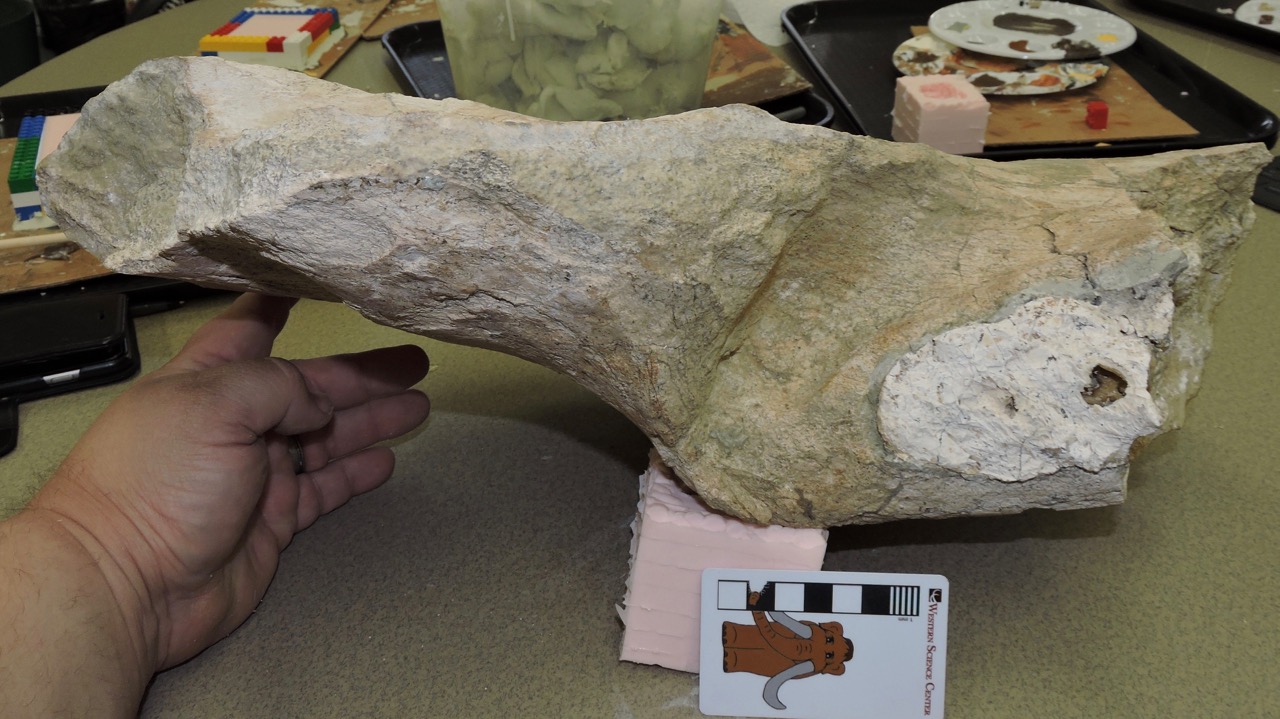 In this view the broken tooth is more clearly visible. Even though the crown is broken off, the distinctive mastodon tooth shape is clear.Unlike the vast majority of mastodons in the Western Science Center collections, this jaw is not from Diamond Valley Lake. Instead, it was collected from the Grizzly Ridge section of Murrieta, about 20 km southwest of Diamond Valley Lake (still in Riverside County). This specimen came in as part of a mitigation project, and unfortunately included almost no data except for the locality name. Both early and late Pleistocene deposits are known from Murrieta, so we're not yet sure of the age.We have not yet begun preparation of this specimen, but a quick survey indicates that a substantial part of the skeleton was recovered, including at least some vertebrae, numerous ribs, multiple limb elements, and several tusk fragments. We're hoping to prepare the specimen over the next year or so in our new Exploration Station prep area in our main exhibit gallery. The dentary fragment will also be on exhibit during Valley of the Mastodons, opening to the public on August 5.
In this view the broken tooth is more clearly visible. Even though the crown is broken off, the distinctive mastodon tooth shape is clear.Unlike the vast majority of mastodons in the Western Science Center collections, this jaw is not from Diamond Valley Lake. Instead, it was collected from the Grizzly Ridge section of Murrieta, about 20 km southwest of Diamond Valley Lake (still in Riverside County). This specimen came in as part of a mitigation project, and unfortunately included almost no data except for the locality name. Both early and late Pleistocene deposits are known from Murrieta, so we're not yet sure of the age.We have not yet begun preparation of this specimen, but a quick survey indicates that a substantial part of the skeleton was recovered, including at least some vertebrae, numerous ribs, multiple limb elements, and several tusk fragments. We're hoping to prepare the specimen over the next year or so in our new Exploration Station prep area in our main exhibit gallery. The dentary fragment will also be on exhibit during Valley of the Mastodons, opening to the public on August 5.
Fossil Friday - mastodon partial skull
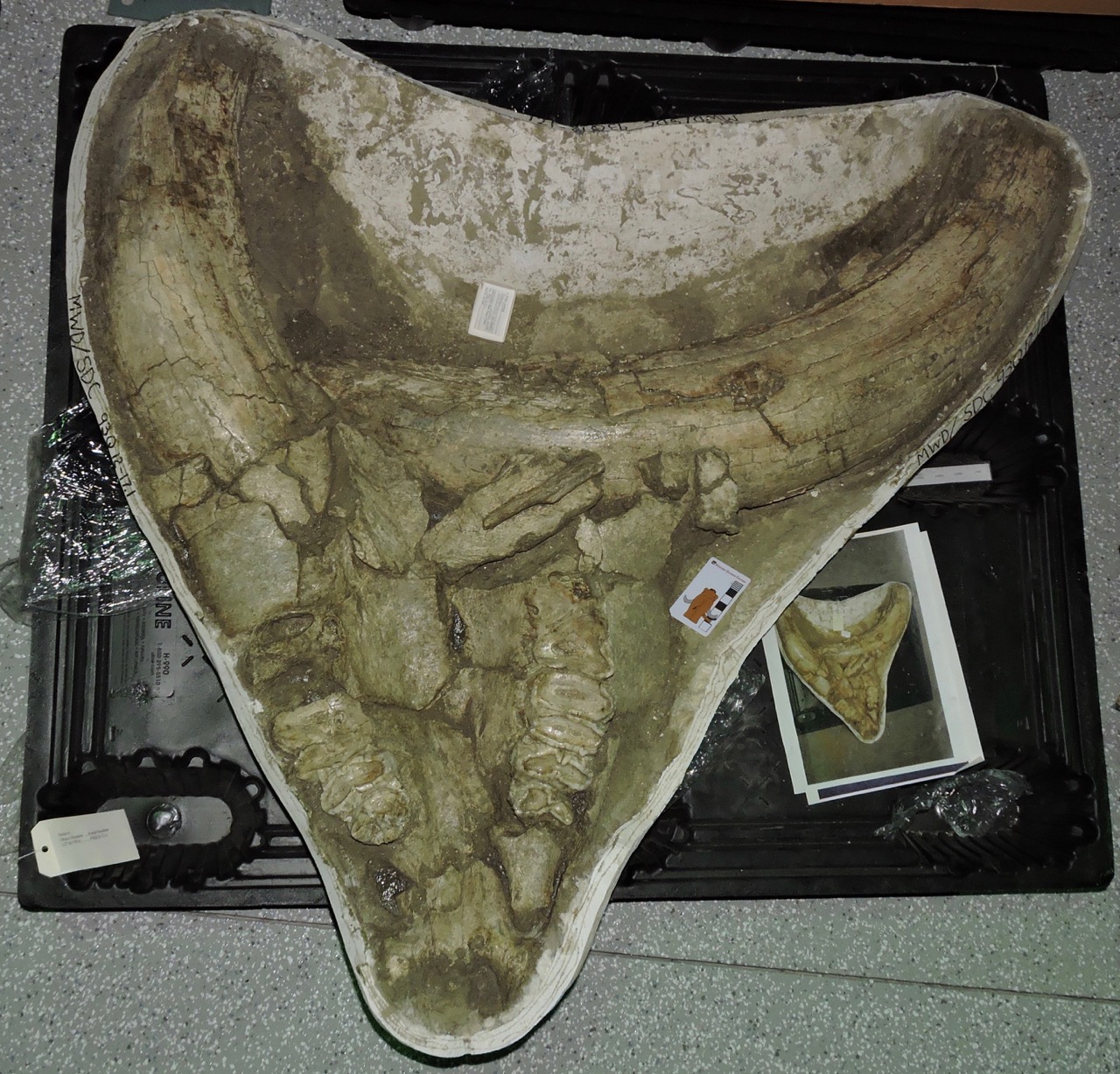 Our latest mastodon installment as we approach the "Valley of the Mastodons" exhibit opening 3 weeks from now is "Braces", a partial mastodon skull from the San Diego Canal."Braces" is still in his field jacket, with the ventral side exposed (and the large tusks do indicate that he's male). Below is an annotated version:
Our latest mastodon installment as we approach the "Valley of the Mastodons" exhibit opening 3 weeks from now is "Braces", a partial mastodon skull from the San Diego Canal."Braces" is still in his field jacket, with the ventral side exposed (and the large tusks do indicate that he's male). Below is an annotated version: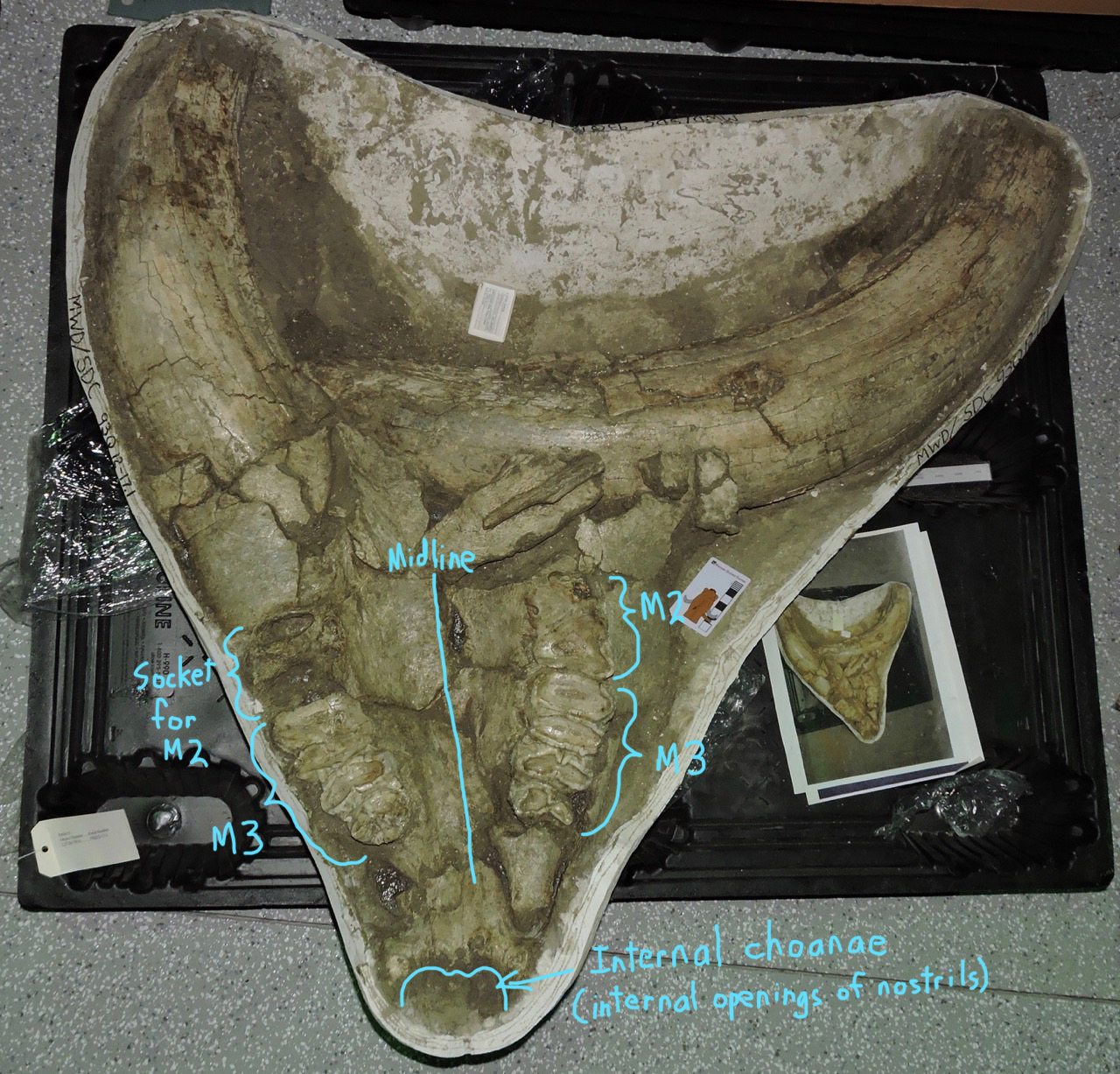 "Braces" was a fully mature mastodon, roughly 40 years old based on tooth wear. The right 2nd molar is missing, and I'm pretty sure it had fallen out well before the mastodon died. It looks like the socket had started closing up, and the corresponding left second molar was worn all the way down to the bone.Braces' name comes from anomalies in the wear pattern on his teeth. Typically, proboscidean teeth wear in a fairly predictable way. The upper teeth wear more rapidly along the interior half of the occlusal surface (the lingual, or tongue-ward, side), while lower teeth wear more rapidly along the exterior half (the labial, or lip-ward, side). This may seem a little confusing, but it just means that when the upper and lower teeth occlude they do so along an angled surface, as shown in this schematic drawing of a cross-section through a mouth:
"Braces" was a fully mature mastodon, roughly 40 years old based on tooth wear. The right 2nd molar is missing, and I'm pretty sure it had fallen out well before the mastodon died. It looks like the socket had started closing up, and the corresponding left second molar was worn all the way down to the bone.Braces' name comes from anomalies in the wear pattern on his teeth. Typically, proboscidean teeth wear in a fairly predictable way. The upper teeth wear more rapidly along the interior half of the occlusal surface (the lingual, or tongue-ward, side), while lower teeth wear more rapidly along the exterior half (the labial, or lip-ward, side). This may seem a little confusing, but it just means that when the upper and lower teeth occlude they do so along an angled surface, as shown in this schematic drawing of a cross-section through a mouth:  Here's a closeup of Braces' right 3rd molar, followed by an annotated version:
Here's a closeup of Braces' right 3rd molar, followed by an annotated version:
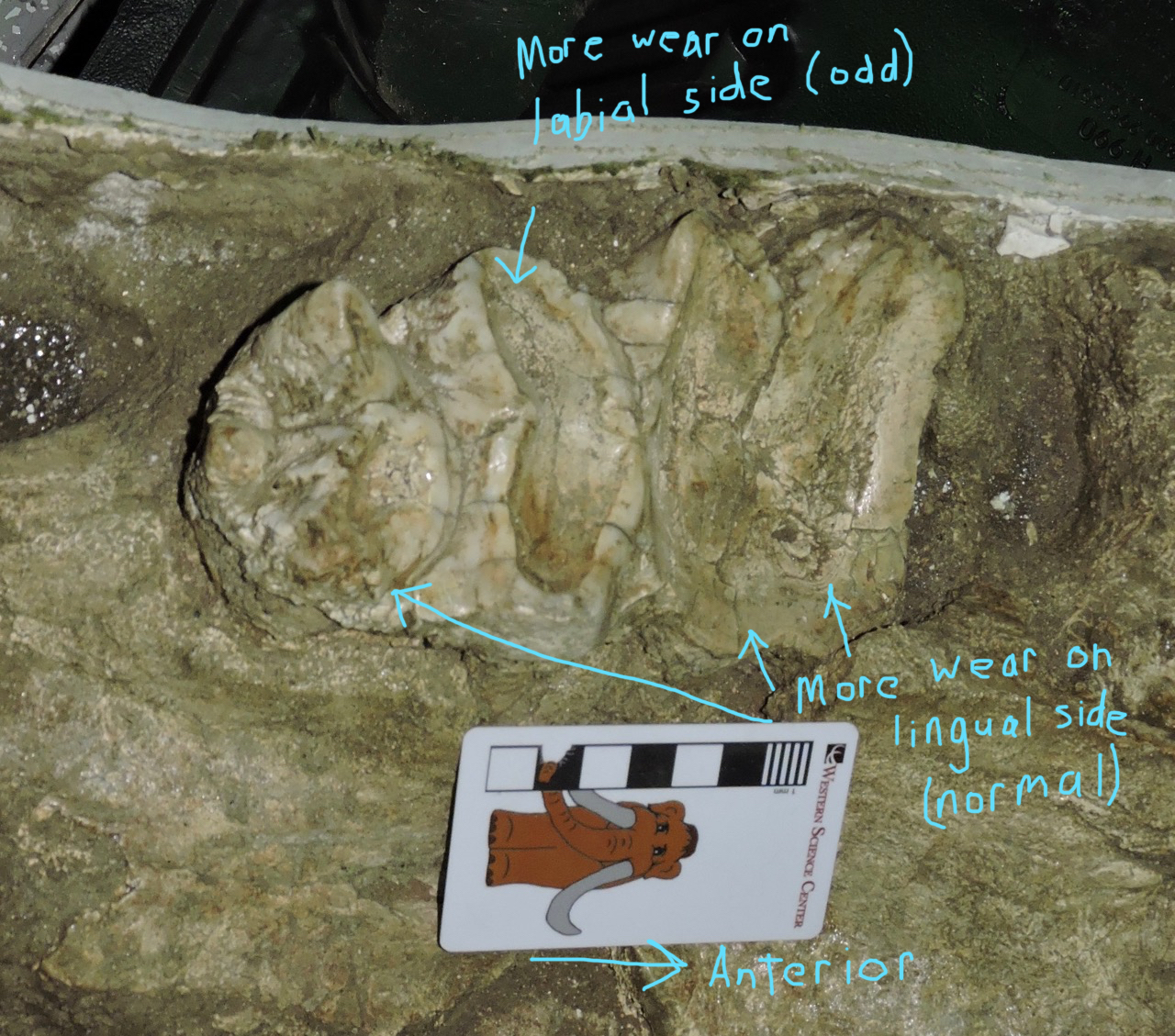 In Braces, the upper 3rd molar starts off wearing just as it should, with much heavier wear on the lingual side. But then, on the third loph, the wear pattern reverses, with heavier wear on the labial side like you would expect to see in a lower tooth. Then, on the fourth loph, the wear switches back to the normal pattern with heavier wear on the lingual side.It seems that there was some anomaly with the way Braces' teeth were aligned and occluding with each other. I'm not sure what caused this. Unfortunately we don't have the lower jaw, which might help. Maybe he had an injury to his lower jaw that changed the way he closed his mouth? Certainly Max, who was a slightly younger animal, had several jaw injuries. Or maybe this has to do with the right 2nd molar being lost before the left on; perhaps that sets up an asymmetry in the chewing dynamics. If this is the case, it's possible that if Braces had lived longer the pattern would have reversed itself. Maybe this is a relatively common but temporary condition, that only occurs during the brief periods when the tooth count is different on each side of the jaw.Along with most of our other mastodons, Braces will be on display in our Valley of the Mastodons exhibit that opens on August 5.
In Braces, the upper 3rd molar starts off wearing just as it should, with much heavier wear on the lingual side. But then, on the third loph, the wear pattern reverses, with heavier wear on the labial side like you would expect to see in a lower tooth. Then, on the fourth loph, the wear switches back to the normal pattern with heavier wear on the lingual side.It seems that there was some anomaly with the way Braces' teeth were aligned and occluding with each other. I'm not sure what caused this. Unfortunately we don't have the lower jaw, which might help. Maybe he had an injury to his lower jaw that changed the way he closed his mouth? Certainly Max, who was a slightly younger animal, had several jaw injuries. Or maybe this has to do with the right 2nd molar being lost before the left on; perhaps that sets up an asymmetry in the chewing dynamics. If this is the case, it's possible that if Braces had lived longer the pattern would have reversed itself. Maybe this is a relatively common but temporary condition, that only occurs during the brief periods when the tooth count is different on each side of the jaw.Along with most of our other mastodons, Braces will be on display in our Valley of the Mastodons exhibit that opens on August 5.
Fossil Friday - mastodon calcaneum
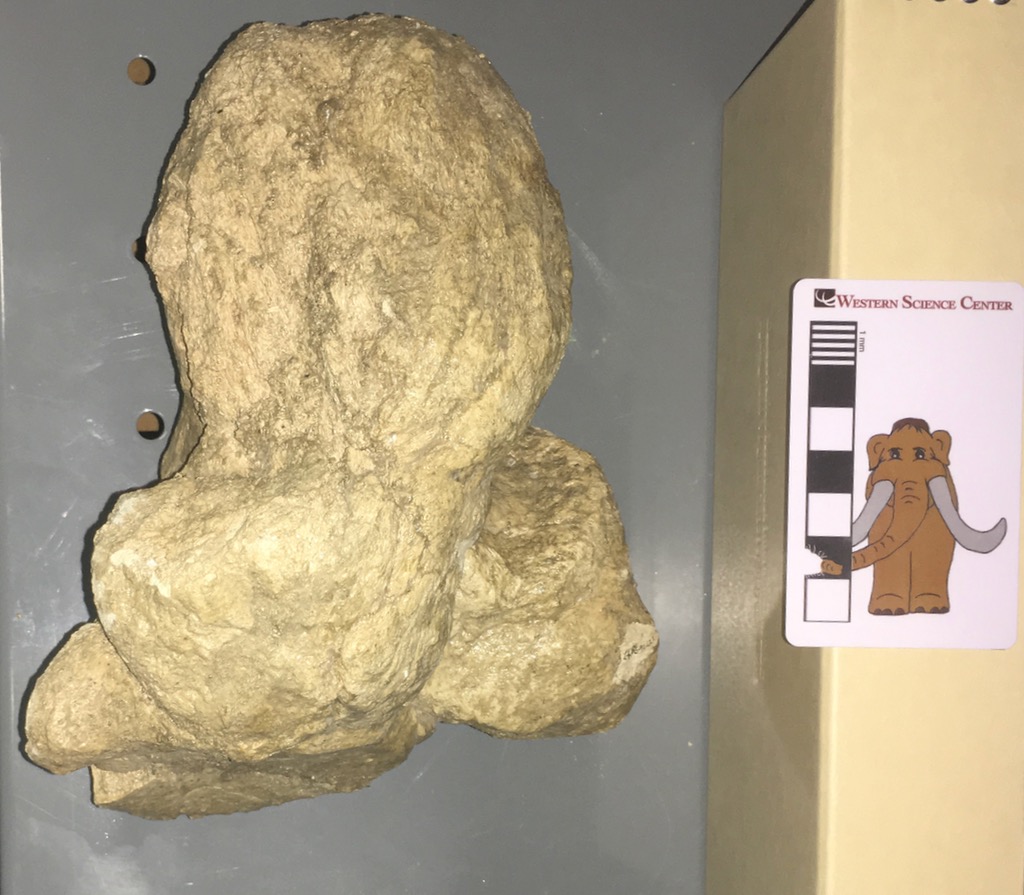 Continuing with our mastodon spree in preparation for next month's "Valley of the Mastodons" workshop and exhibit, this week for Fossil Friday we have a mastodon calcaneum.This is a left calcaneum, seen above in posterior view. The calcaneum is the heel bone, and together with the astragalus makes up the ankle joint. In anterior view (actually anterior and slightly ventral, below) the two bright white surfaces are the articulations with the astragalus:
Continuing with our mastodon spree in preparation for next month's "Valley of the Mastodons" workshop and exhibit, this week for Fossil Friday we have a mastodon calcaneum.This is a left calcaneum, seen above in posterior view. The calcaneum is the heel bone, and together with the astragalus makes up the ankle joint. In anterior view (actually anterior and slightly ventral, below) the two bright white surfaces are the articulations with the astragalus: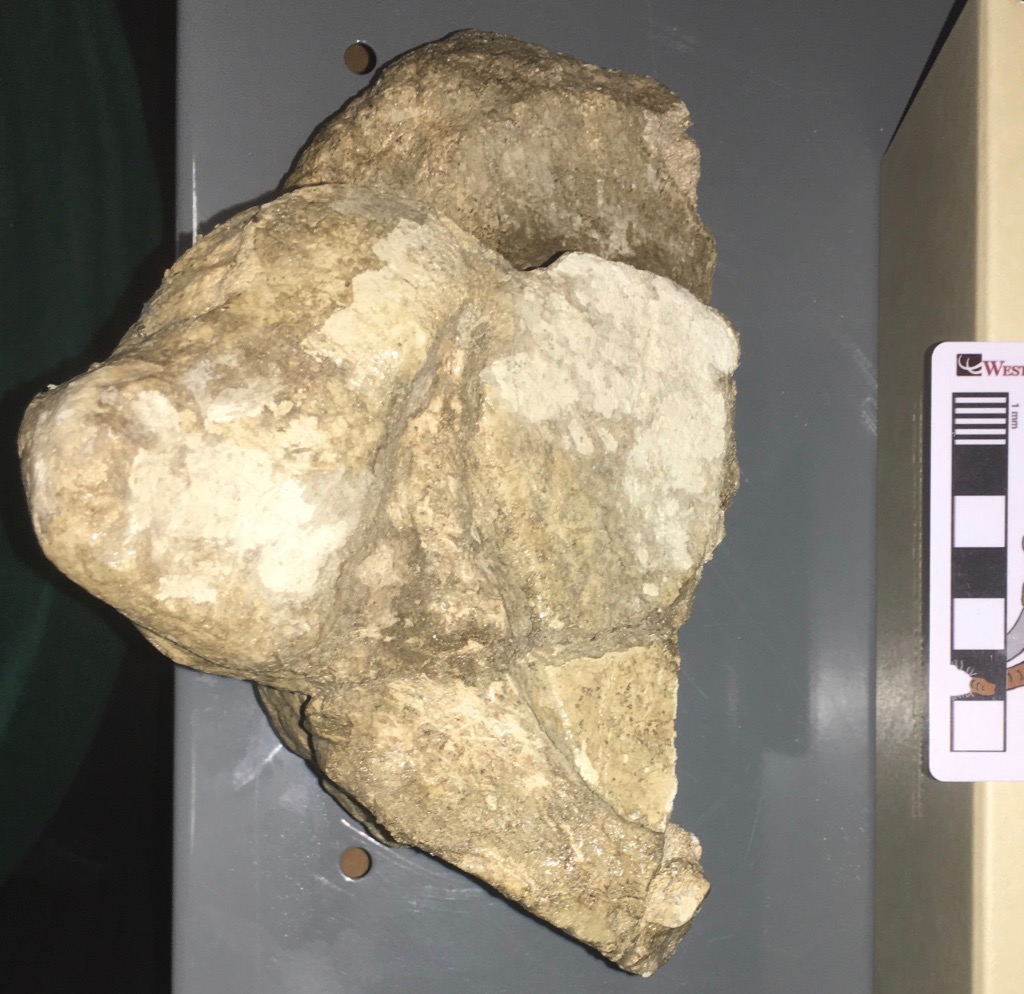 Here's a lateral view, with anterior to the left:
Here's a lateral view, with anterior to the left: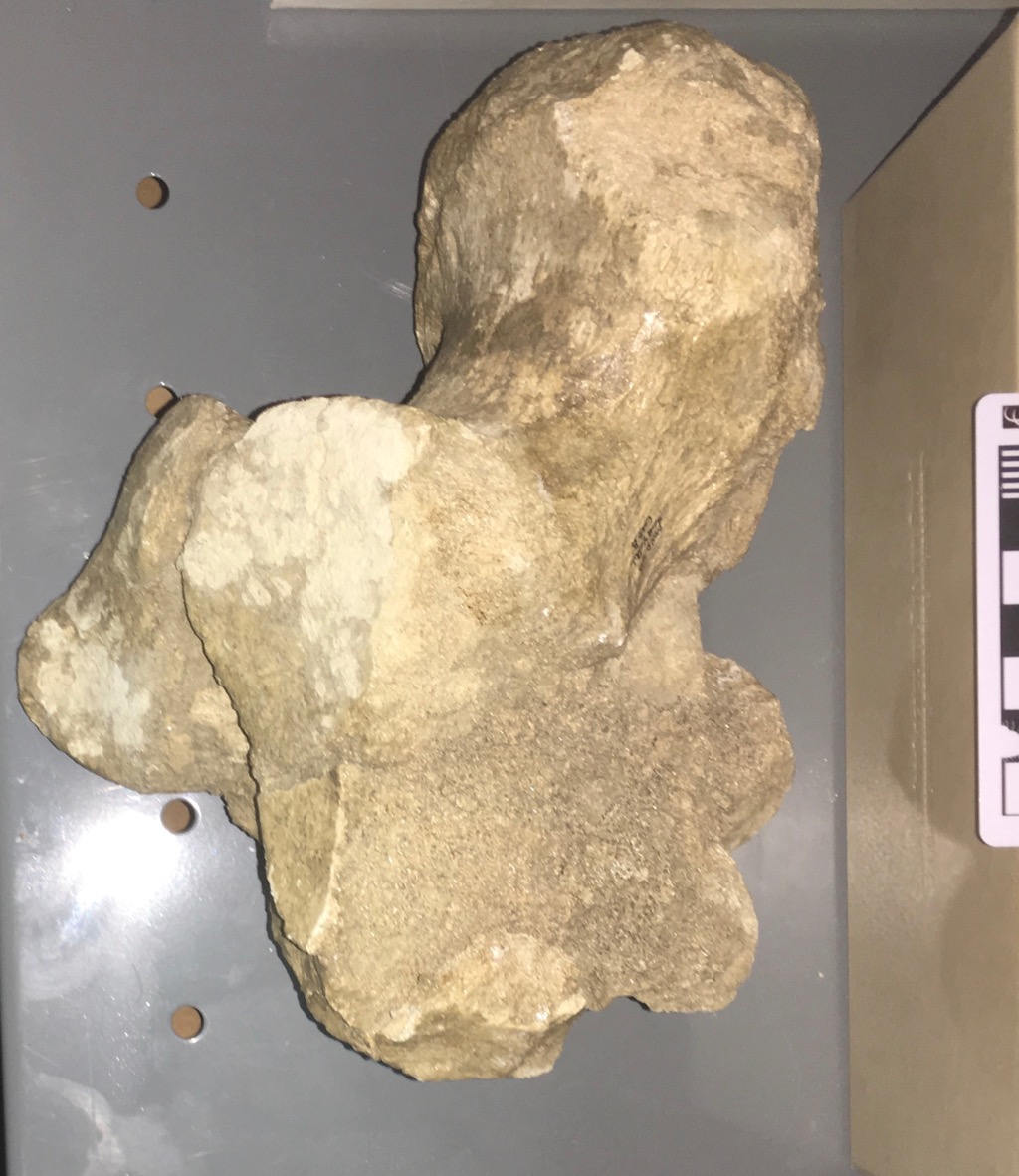 The large mass of bone sticking off the top is called the tuber calcis. Humans are plantigrade animals, meaning that we walk with our feet on the ground. In our feet, the tuber calcis projects down and back, forming our heel. We actually walk on the bottom of the tuber calcis (covered with a thin layer of soft tissue), while various muscles attach to the top surface of the tuber calcis through the Achilles tendon. When these muscles flex the Achilles tendon pulls the tuber calcis up, rotating the foot down. When a ballerina stands en pointe, she is flexing these muscles and keeping the tuber calcis rotated up and forward.Most large mammals are not plantigrade but are instead digitigrade; they are en pointe all the time. However, different limb geometry means that they don't have to constantly flex a group of muscles to stay in that position. Instead, the foot between the ankle and toes acts like an additional leg segment, moving forward and backward at the ankle and held vertically when at rest. (Some people mistakenly believe that animals such as deer and horses have "backward knees"; they're actually looking at the ankle joint, not the knee.)Surprisingly, for all their bulk, proboscideans are digitigrade. Even though the toes are short and stout, the ankle is held high and the calcaneum is off the ground. (See these fantastic CT-based videos of elephant foot bones from What's in John's Freezer to see the relationships of the bones to each other.) When you look at an elephant's feet, it may not immediately be clear that they're digitigrade because there is a huge fatty pad that covers the palm and heel, turning the whole foot into a column. In the hind foot, the top back part of the fat pad is nestled under the calcaneum.Even with their thick, columnar legs, elephants have a fair range of mobility at the ankle, and can move their feet forward and back relative to the shin. This is consistent with the large tuber calcis, which remember serves as a muscle attachment point for pulling the foot back (in this case, pulling it back to the vertical, resting position). What is a bit surprising is that, compared to elephants and mammoths, the tuber calcis in mastodons is enormous, roughly twice as large. Perhaps foot strength and dexterity was more significant in mastodons for some reason?This calcaneum, along with hundreds of other mastodon bones, will be on display in the "Valley of the Mastodons" exhibit at the Western Science Center next month.
The large mass of bone sticking off the top is called the tuber calcis. Humans are plantigrade animals, meaning that we walk with our feet on the ground. In our feet, the tuber calcis projects down and back, forming our heel. We actually walk on the bottom of the tuber calcis (covered with a thin layer of soft tissue), while various muscles attach to the top surface of the tuber calcis through the Achilles tendon. When these muscles flex the Achilles tendon pulls the tuber calcis up, rotating the foot down. When a ballerina stands en pointe, she is flexing these muscles and keeping the tuber calcis rotated up and forward.Most large mammals are not plantigrade but are instead digitigrade; they are en pointe all the time. However, different limb geometry means that they don't have to constantly flex a group of muscles to stay in that position. Instead, the foot between the ankle and toes acts like an additional leg segment, moving forward and backward at the ankle and held vertically when at rest. (Some people mistakenly believe that animals such as deer and horses have "backward knees"; they're actually looking at the ankle joint, not the knee.)Surprisingly, for all their bulk, proboscideans are digitigrade. Even though the toes are short and stout, the ankle is held high and the calcaneum is off the ground. (See these fantastic CT-based videos of elephant foot bones from What's in John's Freezer to see the relationships of the bones to each other.) When you look at an elephant's feet, it may not immediately be clear that they're digitigrade because there is a huge fatty pad that covers the palm and heel, turning the whole foot into a column. In the hind foot, the top back part of the fat pad is nestled under the calcaneum.Even with their thick, columnar legs, elephants have a fair range of mobility at the ankle, and can move their feet forward and back relative to the shin. This is consistent with the large tuber calcis, which remember serves as a muscle attachment point for pulling the foot back (in this case, pulling it back to the vertical, resting position). What is a bit surprising is that, compared to elephants and mammoths, the tuber calcis in mastodons is enormous, roughly twice as large. Perhaps foot strength and dexterity was more significant in mastodons for some reason?This calcaneum, along with hundreds of other mastodon bones, will be on display in the "Valley of the Mastodons" exhibit at the Western Science Center next month.
Fossil Friday - mastodon axis vertebra
 With the opening of the Valley of the Mastodons exhibit a little over a month away, we've started pulling specimens from the collections to work on layouts. The lab and collections workroom are full of mastodons!Today's specimen is a mastodon 2nd cervical (neck) vertebrae, more commonly referred to as the axis. It's shown above in anterior view, and below in posterior view:
With the opening of the Valley of the Mastodons exhibit a little over a month away, we've started pulling specimens from the collections to work on layouts. The lab and collections workroom are full of mastodons!Today's specimen is a mastodon 2nd cervical (neck) vertebrae, more commonly referred to as the axis. It's shown above in anterior view, and below in posterior view: Animals with large heads face real biomechanical hurdles. If you're a quadruped, your head is stuck out on the end of a neck and is otherwise unsupported. This puts tremendous stress on the neck vertebrae, and requires massive muscles to hold up the weight, which affects the entire skeleton. In proboscideans the problem is even worse, because they have a large, heavy brain and, right out in front where it causes the most stress, massively heavy teeth, tusks, and trunk. Proboscideans have addressed this issue in two ways: the skull itself is actually pretty lightly built for its size, and the neck vertebrae are compressed front to back so that the neck is relatively short. But even with a short neck, elephants sometimes need to move their heads. So while the neck vertebrae are short, they have massive attachment areas for muscles and some range of mobility between the vertebrae. The huge, robust neural arch and spine on this mastodon vertebra reflect the large muscles attached to it. Just as a "gee, whiz!" point, the mass of bone that forms the top of the neural canal is roughly the same size as the entire centrum of a bison cervical vertebra, and it's not as if bison have tiny heads!In most mammals, nodding the head up and down largely involves movement between the skull and the first cervical vertebra (the atlas). In contrast, if an animal rotates its head along a longitudinal axis, such as the RCA dog below (from Wikipedia), or the elephant in this video, much of the movement is occurring between the atlas and axis vertebrae.
Animals with large heads face real biomechanical hurdles. If you're a quadruped, your head is stuck out on the end of a neck and is otherwise unsupported. This puts tremendous stress on the neck vertebrae, and requires massive muscles to hold up the weight, which affects the entire skeleton. In proboscideans the problem is even worse, because they have a large, heavy brain and, right out in front where it causes the most stress, massively heavy teeth, tusks, and trunk. Proboscideans have addressed this issue in two ways: the skull itself is actually pretty lightly built for its size, and the neck vertebrae are compressed front to back so that the neck is relatively short. But even with a short neck, elephants sometimes need to move their heads. So while the neck vertebrae are short, they have massive attachment areas for muscles and some range of mobility between the vertebrae. The huge, robust neural arch and spine on this mastodon vertebra reflect the large muscles attached to it. Just as a "gee, whiz!" point, the mass of bone that forms the top of the neural canal is roughly the same size as the entire centrum of a bison cervical vertebra, and it's not as if bison have tiny heads!In most mammals, nodding the head up and down largely involves movement between the skull and the first cervical vertebra (the atlas). In contrast, if an animal rotates its head along a longitudinal axis, such as the RCA dog below (from Wikipedia), or the elephant in this video, much of the movement is occurring between the atlas and axis vertebrae. (OK, the pedant in me has to point out that, while nodding and rotating largely involve the atlas and axis respectively, the rest of the cervical vertebrae are also involved in these movements, so injury or fusion at any point in the neck will cause a decrease in mobility. In addition, humans, because our bipedal stance has resulted in precariously-balanced and misshapen heads, work a bit differently. From a vertebral standpoint, our equivalent motion to what the RCA dog is would be looking from left-to-right, but when we cock our head to the side, that's the vertebral equivalent to looking left-to-right in other mammals. Finally, the necks in non-mammal tetrapods such as reptiles and birds work quite differently from mammals, so much of this doesn't apply to them.)The mastodon axis shown here is actually part of an associated skeleton that came from the West Dam of Diamond Valley Lake, which includes several other vertebrae, tusks, and a number of ribs. Like most of our mastodon material, it will be on exhibit starting in August.
(OK, the pedant in me has to point out that, while nodding and rotating largely involve the atlas and axis respectively, the rest of the cervical vertebrae are also involved in these movements, so injury or fusion at any point in the neck will cause a decrease in mobility. In addition, humans, because our bipedal stance has resulted in precariously-balanced and misshapen heads, work a bit differently. From a vertebral standpoint, our equivalent motion to what the RCA dog is would be looking from left-to-right, but when we cock our head to the side, that's the vertebral equivalent to looking left-to-right in other mammals. Finally, the necks in non-mammal tetrapods such as reptiles and birds work quite differently from mammals, so much of this doesn't apply to them.)The mastodon axis shown here is actually part of an associated skeleton that came from the West Dam of Diamond Valley Lake, which includes several other vertebrae, tusks, and a number of ribs. Like most of our mastodon material, it will be on exhibit starting in August.
Fossil Friday - mastodon caudal vertebra
 As promised, as we prepare for the Valley of the Mastodons workshop and exhibit, I'm going to be talking even more than usual about mastodons. We have hundreds of mastodon bones in the WSC collections, and we have to examine them all over the next month to decide what's going on exhibit (which will be most of them).The small bone shown above is a caudal (tail) vertebra, shown in dorsal view with anterior at the top. The ventral view is below:
As promised, as we prepare for the Valley of the Mastodons workshop and exhibit, I'm going to be talking even more than usual about mastodons. We have hundreds of mastodon bones in the WSC collections, and we have to examine them all over the next month to decide what's going on exhibit (which will be most of them).The small bone shown above is a caudal (tail) vertebra, shown in dorsal view with anterior at the top. The ventral view is below: Looking at elephant tails for comparison (there isn't a lot of literature on mastodon tails!) this vertebra appears to come from roughly the middle of the tail. Proboscidean tails are relatively limited in use (modern elephants will use them to brush off insects, babies will sometimes hold onto their mother's tail, etc.), so the more distal vertebrae are quite simple. This vertebra has a neural canal (the passage for the spinal cord) that is open dorsally and very small transverse processes, both typical for proboscidean caudal vertebrae.In anterior view (below) we can see that the vertebra is also missing the epiphysis that forms the end of the bone:
Looking at elephant tails for comparison (there isn't a lot of literature on mastodon tails!) this vertebra appears to come from roughly the middle of the tail. Proboscidean tails are relatively limited in use (modern elephants will use them to brush off insects, babies will sometimes hold onto their mother's tail, etc.), so the more distal vertebrae are quite simple. This vertebra has a neural canal (the passage for the spinal cord) that is open dorsally and very small transverse processes, both typical for proboscidean caudal vertebrae.In anterior view (below) we can see that the vertebra is also missing the epiphysis that forms the end of the bone: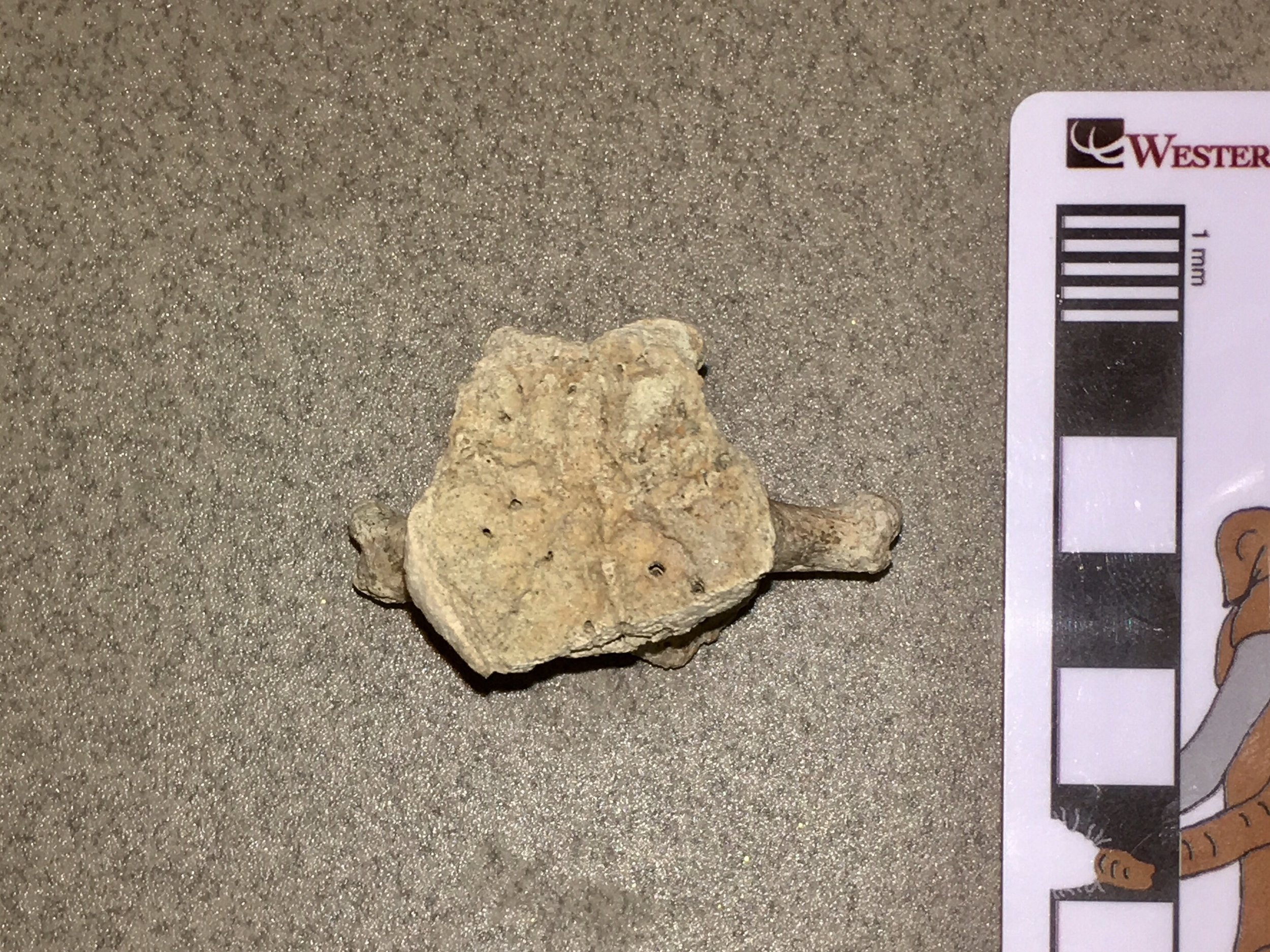 An unfused epiphysis is typically indicative of a bone that was still growing, suggesting that this was a relatively young animal. In fact, this vertebra is part of the associated skeleton of "Little Stevie", the most complete mastodon from Diamond Valley Lake. Based on his teeth and bone development, "Stevie" was a late adolescent, probably somewhere in the range of 18-22 years old.This vertebra, along with hundreds of other mastodon bones, will be on exhibit starting this August with the opening of Valley of the Mastodons.
An unfused epiphysis is typically indicative of a bone that was still growing, suggesting that this was a relatively young animal. In fact, this vertebra is part of the associated skeleton of "Little Stevie", the most complete mastodon from Diamond Valley Lake. Based on his teeth and bone development, "Stevie" was a late adolescent, probably somewhere in the range of 18-22 years old.This vertebra, along with hundreds of other mastodon bones, will be on exhibit starting this August with the opening of Valley of the Mastodons.
Fossil Friday - mastodon molar
 This August we're opening a major new exhibit and hosting an associated workshop at Western Science Center, Valley of the Mastodons. In the lead-up to the exhibit/workshop, I'm going to be talking about mastodons even more than usual.The specimen shown above is a heavily-worn tooth in occlusal view. The anterior end of the tooth is at the top, and two corners are broken off. Based on the size, shape, and wear pattern, this appears to be an upper right 1st molar.Below is a lateral (labial) view, with anterior to the right:
This August we're opening a major new exhibit and hosting an associated workshop at Western Science Center, Valley of the Mastodons. In the lead-up to the exhibit/workshop, I'm going to be talking about mastodons even more than usual.The specimen shown above is a heavily-worn tooth in occlusal view. The anterior end of the tooth is at the top, and two corners are broken off. Based on the size, shape, and wear pattern, this appears to be an upper right 1st molar.Below is a lateral (labial) view, with anterior to the right: In this view it's clear that this tooth is almost completely worn away. The wear is heaviest at the anterior end, which is typical for proboscideans with horizontal tooth replacement. As this is an upper tooth, the wear is actually lighter on this side than on the medial (lingual) surface.This tooth was found along the San Diego Canal, apparently near the mastodon jaw we CT scanned a few weeks ago. However, it doesn't appear to be from the same animal, as that specimen had apparently lost its first molars some substantial amount of time prior to its death. This tooth, as well as nearly all of our other mastodon remains, will be on display this August in Valley of the Mastodons.
In this view it's clear that this tooth is almost completely worn away. The wear is heaviest at the anterior end, which is typical for proboscideans with horizontal tooth replacement. As this is an upper tooth, the wear is actually lighter on this side than on the medial (lingual) surface.This tooth was found along the San Diego Canal, apparently near the mastodon jaw we CT scanned a few weeks ago. However, it doesn't appear to be from the same animal, as that specimen had apparently lost its first molars some substantial amount of time prior to its death. This tooth, as well as nearly all of our other mastodon remains, will be on display this August in Valley of the Mastodons.
Fossil Friday - Bison humerus
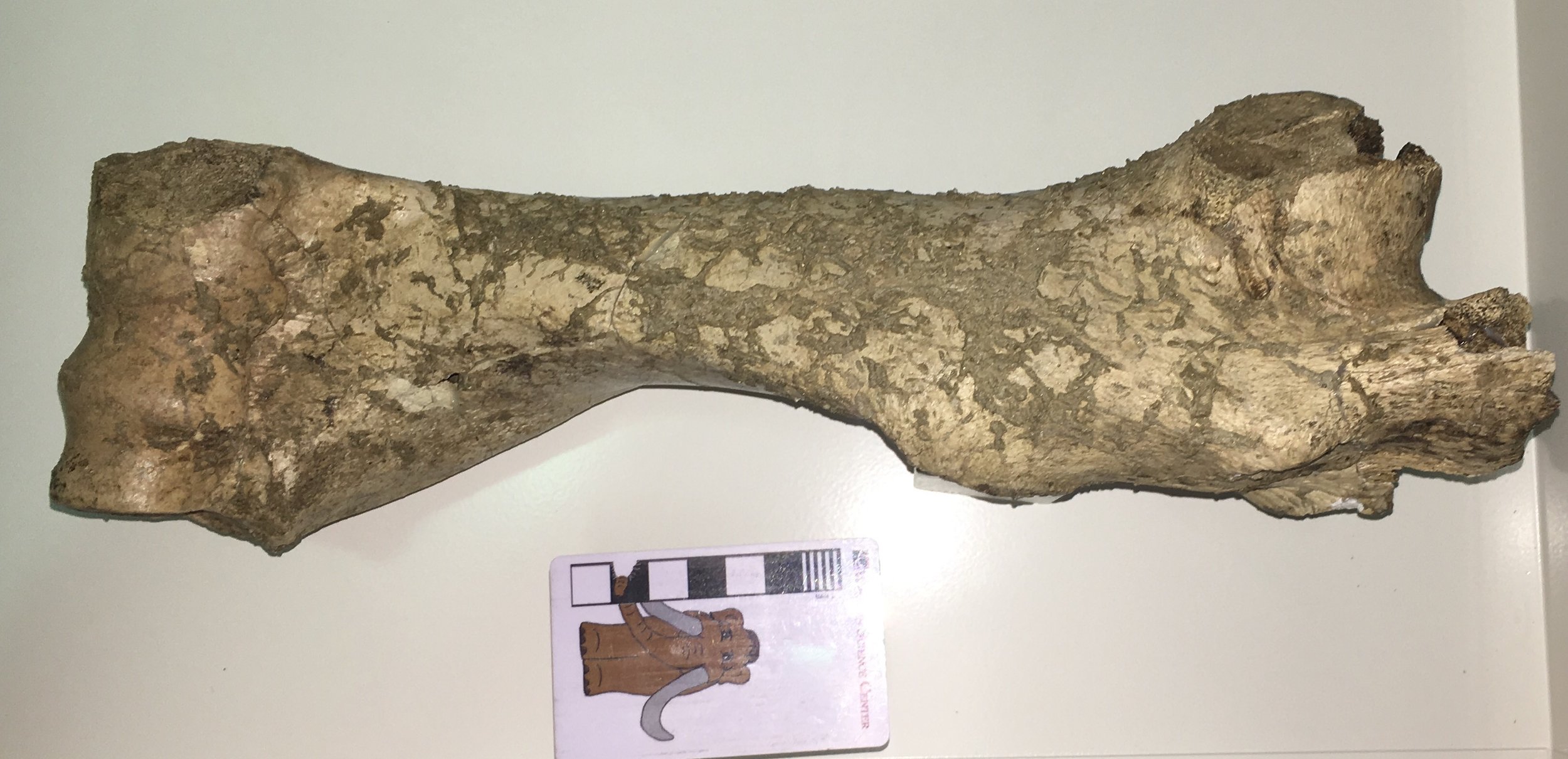 This rather stout bone is one of our best-preserved bison humeri. This is the left humerus, shown above in anterior view. The distal end, at the elbow joint, is on the left, while the proximal end (shoulder joint) is on the right. Bison have a large knob of bone called the lateral tuberosity which is broken off of this specimen; it should be at located at the lower right. The darker lines and patches are sediment that has not yet been removed. Below is the posterior view:
This rather stout bone is one of our best-preserved bison humeri. This is the left humerus, shown above in anterior view. The distal end, at the elbow joint, is on the left, while the proximal end (shoulder joint) is on the right. Bison have a large knob of bone called the lateral tuberosity which is broken off of this specimen; it should be at located at the lower right. The darker lines and patches are sediment that has not yet been removed. Below is the posterior view: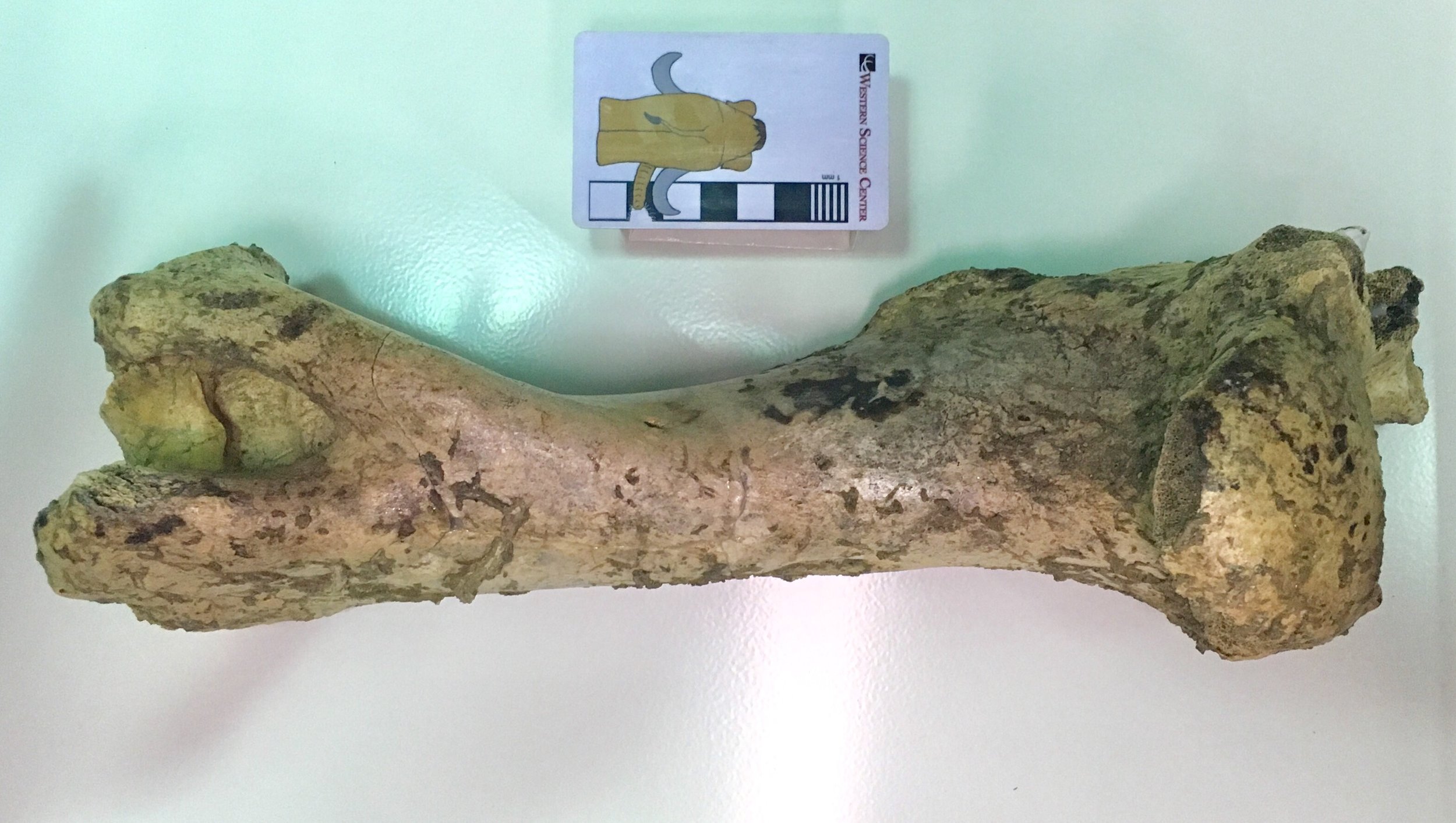 Again, proximal is on the right. The large humoral head that articulates with the scapula to form the shoulder joint is visible on the right. The large notch on the distal end (on the left) is the olecranon fossa. This accommodates the olecranon process of the ulna (the point of the elbow) when the front leg is extended.Here are the lateral and medial views:
Again, proximal is on the right. The large humoral head that articulates with the scapula to form the shoulder joint is visible on the right. The large notch on the distal end (on the left) is the olecranon fossa. This accommodates the olecranon process of the ulna (the point of the elbow) when the front leg is extended.Here are the lateral and medial views: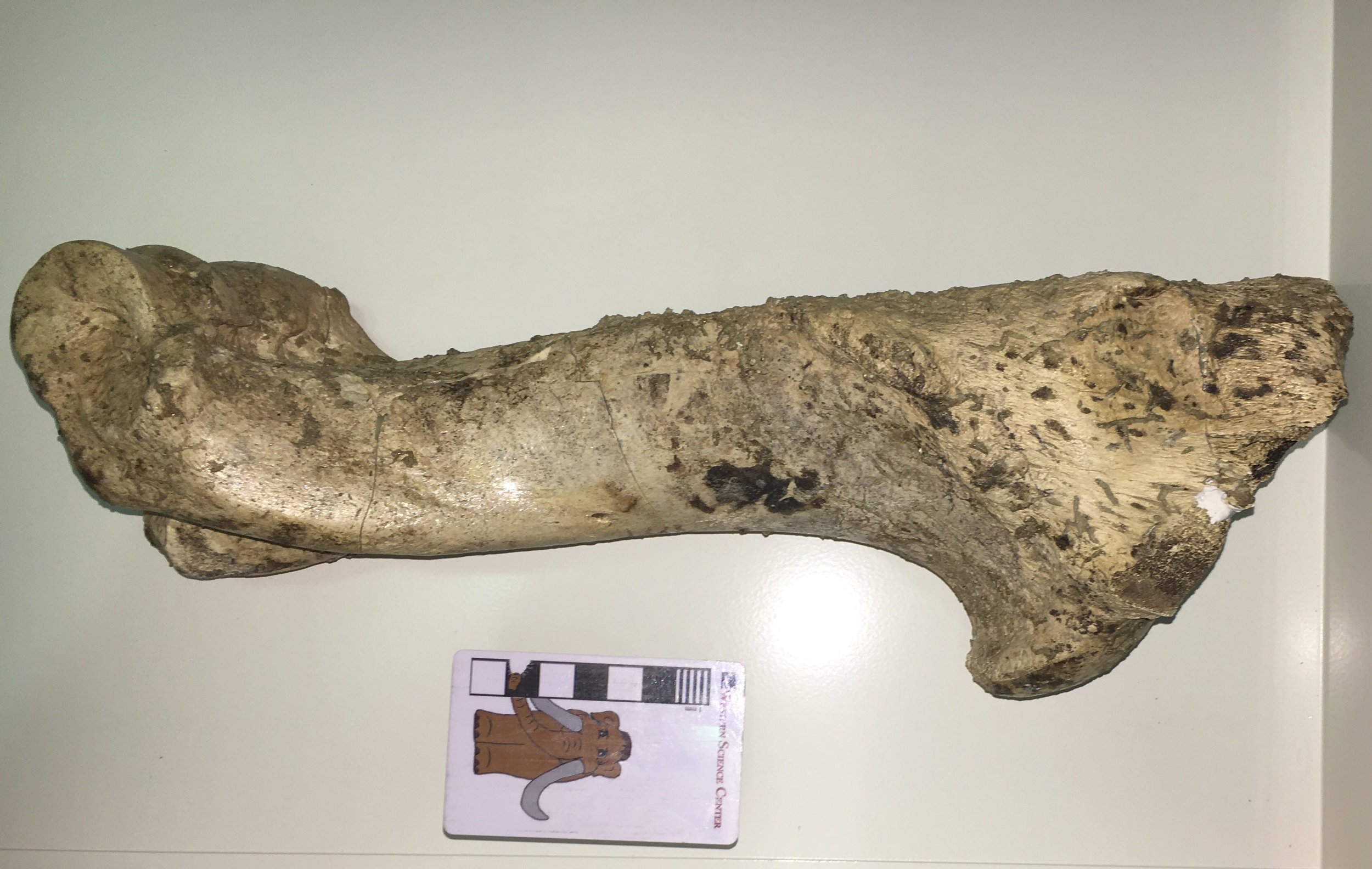
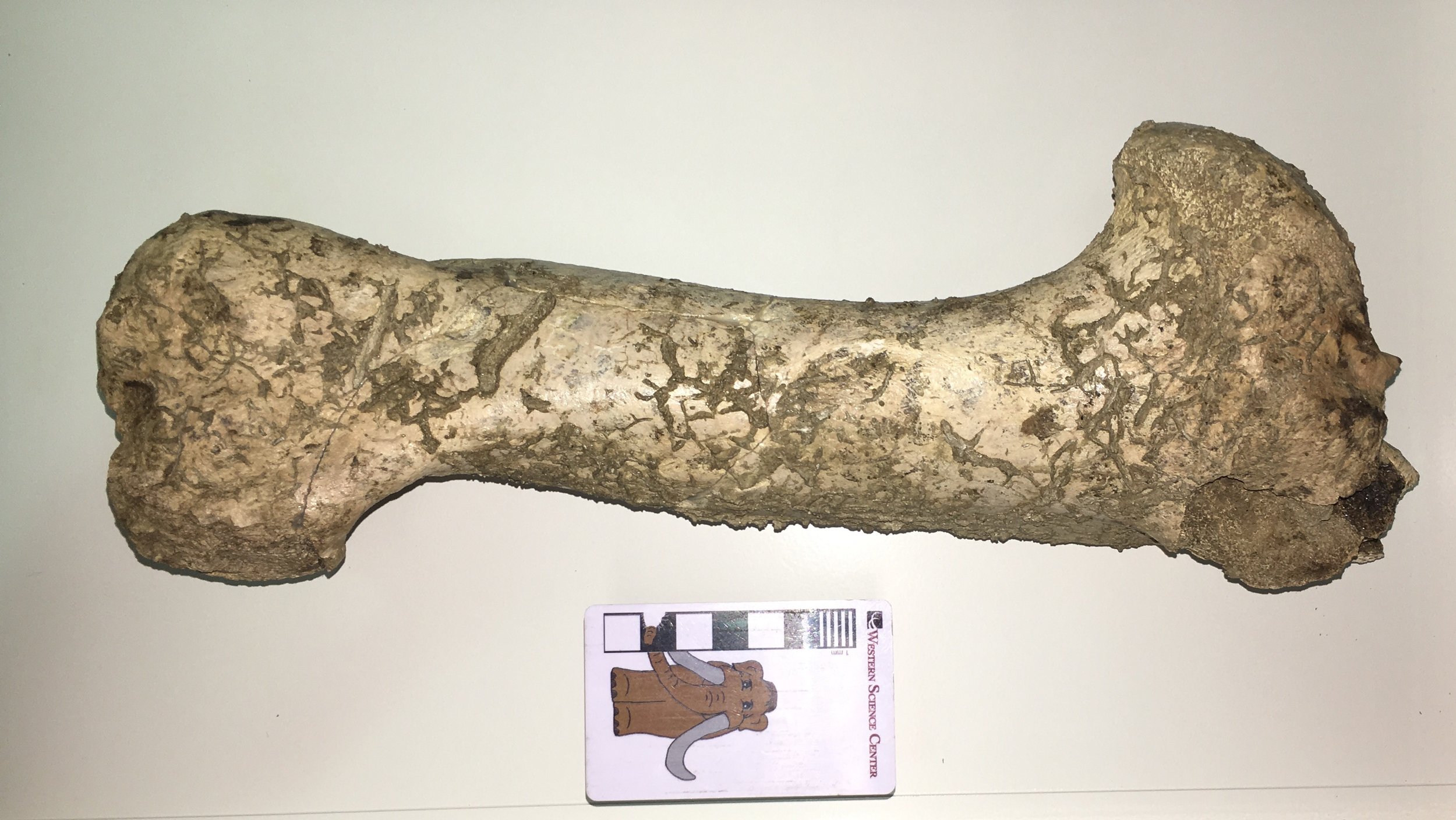 Damage is visible at the proximal end in these views, where the lateral tuberosity was originally located. This humerus was found at the West Dam of Diamond Valley Lake. West Dam deposits are older than those at the East Dam, and contain both Bison antiquus and Bison latifrons; it's not clear which species is represented here.
Damage is visible at the proximal end in these views, where the lateral tuberosity was originally located. This humerus was found at the West Dam of Diamond Valley Lake. West Dam deposits are older than those at the East Dam, and contain both Bison antiquus and Bison latifrons; it's not clear which species is represented here.
Fossil Friday - new mastodon CT scans
 Almost two years ago we took Max's lower jaw to California Imaging and Diagnostics for a CT scan. We got some fascinating data that raised a lot of new questions, so to help answer them we recently took a second mastodon to CID for scanning.The particular specimen is from the San Diego Canal, and includes a nearly complete lower jaw and a partial cranium. The cranium was of particular interest to us. It was broken in such a way as to include the entire left tooth row including the tusk, but the fragment was narrow enough to fit through the medical CT scanner; a complete adult mastodon skull is typically far too large to fit through the scanner. Based on tooth wear, while this mastodon was an adult he (it appears to be a male) was as much as 10 years younger than Max, so it gives us an interesting point for comparison. We're still examining the data, so what I'm posting here is preliminary (I only examined most of the data myself for the first time yesterday):Here's a transverse section through the SDC specimen's lower jaw, cutting through the last roots on the 3rd molars:
Almost two years ago we took Max's lower jaw to California Imaging and Diagnostics for a CT scan. We got some fascinating data that raised a lot of new questions, so to help answer them we recently took a second mastodon to CID for scanning.The particular specimen is from the San Diego Canal, and includes a nearly complete lower jaw and a partial cranium. The cranium was of particular interest to us. It was broken in such a way as to include the entire left tooth row including the tusk, but the fragment was narrow enough to fit through the medical CT scanner; a complete adult mastodon skull is typically far too large to fit through the scanner. Based on tooth wear, while this mastodon was an adult he (it appears to be a male) was as much as 10 years younger than Max, so it gives us an interesting point for comparison. We're still examining the data, so what I'm posting here is preliminary (I only examined most of the data myself for the first time yesterday):Here's a transverse section through the SDC specimen's lower jaw, cutting through the last roots on the 3rd molars: For comparison here's a similar section through Max's jaw:
For comparison here's a similar section through Max's jaw: The SDC mastodon was a young animal, probably in his early 20's. His 3rd molars were still growing, and had large open pulp cavities and short roots. Max was a middle-aged mastodon in his mid-to-late 30's, with fully developed 3rd molars with deep roots and nearly closed pulp cavities.Here's a sagittal section through the SDC specimen's right dentary, followed by a similar section on Max:
The SDC mastodon was a young animal, probably in his early 20's. His 3rd molars were still growing, and had large open pulp cavities and short roots. Max was a middle-aged mastodon in his mid-to-late 30's, with fully developed 3rd molars with deep roots and nearly closed pulp cavities.Here's a sagittal section through the SDC specimen's right dentary, followed by a similar section on Max:
 This view also emphasizes the huge open pulp cavity in the SDC specimen compared to Max's nearly solid teeth.Here's another sagittal section through the SDC right dentary, on a slightly different plane than the image above:
This view also emphasizes the huge open pulp cavity in the SDC specimen compared to Max's nearly solid teeth.Here's another sagittal section through the SDC right dentary, on a slightly different plane than the image above: Notice the differently-textured bone just in front of the 2nd molar, outlined in red below:
Notice the differently-textured bone just in front of the 2nd molar, outlined in red below: With their horizontal tooth replacement, proboscidean teeth are constantly moving forward in the jaw, which means the bone in the jaw is constantly being absorbed and redeposited. The SDC specimen had recently lost his first molar, and the socket is filled by young, spongy bone that shows up as a different texture in the scan. In the much older Max this part of the jaw is as dense as the surrounding bone.Below is a transverse section through the cranium, followed by a marked-up version. I've rotated the image so that it's approximately in life orientation (it was upside down in the scanner):
With their horizontal tooth replacement, proboscidean teeth are constantly moving forward in the jaw, which means the bone in the jaw is constantly being absorbed and redeposited. The SDC specimen had recently lost his first molar, and the socket is filled by young, spongy bone that shows up as a different texture in the scan. In the much older Max this part of the jaw is as dense as the surrounding bone.Below is a transverse section through the cranium, followed by a marked-up version. I've rotated the image so that it's approximately in life orientation (it was upside down in the scanner):
 The blue area is the 3rd molar, at about the level of the 2nd lophid. The red area is actually the bottom of the unerupted part of the tusk, which extends all the way back at least to the 3rd molar. We can't tell in this specimen just how far back the tusk goes, because it's curving upward and the upper part of the cranium wasn't preserved.Finally, here's a section though a more distal part of the tusk:
The blue area is the 3rd molar, at about the level of the 2nd lophid. The red area is actually the bottom of the unerupted part of the tusk, which extends all the way back at least to the 3rd molar. We can't tell in this specimen just how far back the tusk goes, because it's curving upward and the upper part of the cranium wasn't preserved.Finally, here's a section though a more distal part of the tusk: Again, this is rotated into approximately life orientation. One side of the tusk is damaged, and splinters of the tusk have broken off the inside and are laying haphazardly in the pulp cavity (which also contains some sediment). The better-preserved area shows visible concentric lines, the tusk's growth rings.We'll be studying these new scans in detail over the summer and fall, so there will be more to come. Thanks to CID for providing access to their CT scanner and running these scans for us!
Again, this is rotated into approximately life orientation. One side of the tusk is damaged, and splinters of the tusk have broken off the inside and are laying haphazardly in the pulp cavity (which also contains some sediment). The better-preserved area shows visible concentric lines, the tusk's growth rings.We'll be studying these new scans in detail over the summer and fall, so there will be more to come. Thanks to CID for providing access to their CT scanner and running these scans for us!
Fossil Friday - mammoth jaw
 Most of the current collections growth at the Western Science Center comes in the form of mitigation projects, fossils and artifacts that are recovered during various construction projects. Most of the projects that have come to us are from Riverside County, but we're increasingly starting to bring in material from other areas.Earlier this week we received several Colombian mammoth bones from a Caltrans road project in Merced County, California. The fossils were recovered and beautifully prepared by PaleoResource Consultants. While it appears that all the bones are mammoth, they do not appear to all come from one individual.One of the best-preserved elements is a lower jaw, shown above in dorsal view. The tooth in place is quite small, and is apparently either the fourth premolar or the first molar (I'm leaning toward the 4th premolar, but I need to examine it further to be sure). That makes this a very young animal; if the tooth is the 4th premolar it was probably only about 3 years old, and if it's the 1st molar it would still only be about 13 years old. There are going to be lots of things to work on in this small but significant collection.Thanks to Caltrans and PaleoResources Consultants for bring us this exciting specimen, and to Pat Holroyd at the UC Berkeley Museum of Paleontology, who put us in touch with PaleoResources.
Most of the current collections growth at the Western Science Center comes in the form of mitigation projects, fossils and artifacts that are recovered during various construction projects. Most of the projects that have come to us are from Riverside County, but we're increasingly starting to bring in material from other areas.Earlier this week we received several Colombian mammoth bones from a Caltrans road project in Merced County, California. The fossils were recovered and beautifully prepared by PaleoResource Consultants. While it appears that all the bones are mammoth, they do not appear to all come from one individual.One of the best-preserved elements is a lower jaw, shown above in dorsal view. The tooth in place is quite small, and is apparently either the fourth premolar or the first molar (I'm leaning toward the 4th premolar, but I need to examine it further to be sure). That makes this a very young animal; if the tooth is the 4th premolar it was probably only about 3 years old, and if it's the 1st molar it would still only be about 13 years old. There are going to be lots of things to work on in this small but significant collection.Thanks to Caltrans and PaleoResources Consultants for bring us this exciting specimen, and to Pat Holroyd at the UC Berkeley Museum of Paleontology, who put us in touch with PaleoResources.
Fossil Friday - Paramylodon claw
 Sloths are fascinating animals, with all kinds of strange anatomical features. One of their signature characters is their enormous claws. Although bones from the ground sloth Paramylodon are relatively common at Diamond Valley Lake, only a few claws were recovered. Technically, what usually preserves is the last finger bone, technically called the terminal phalanx or ungal. This is shown above from the side, and below from above:
Sloths are fascinating animals, with all kinds of strange anatomical features. One of their signature characters is their enormous claws. Although bones from the ground sloth Paramylodon are relatively common at Diamond Valley Lake, only a few claws were recovered. Technically, what usually preserves is the last finger bone, technically called the terminal phalanx or ungal. This is shown above from the side, and below from above: While we sometimes refer to ungals informally as "claws", it's important to recognize that the ungal is actually the bone that supports the claw. The claw itself is a keratin sheath that fits over the ungal. Keratin is rarely preserved, but there are a few mummified sloths (I don't think Paramylodon is one of them) in which the keratin claw is preserved; it is generally much longer than the ungal.Sloth ungals are always crowd pleasers at outreach events, so we recently molded this specimen and have started producing casts. Now that the molds are completed, the original claw will go back on permanent exhibit in the museum.
While we sometimes refer to ungals informally as "claws", it's important to recognize that the ungal is actually the bone that supports the claw. The claw itself is a keratin sheath that fits over the ungal. Keratin is rarely preserved, but there are a few mummified sloths (I don't think Paramylodon is one of them) in which the keratin claw is preserved; it is generally much longer than the ungal.Sloth ungals are always crowd pleasers at outreach events, so we recently molded this specimen and have started producing casts. Now that the molds are completed, the original claw will go back on permanent exhibit in the museum.
Fossil Friday - proboscidean ulna
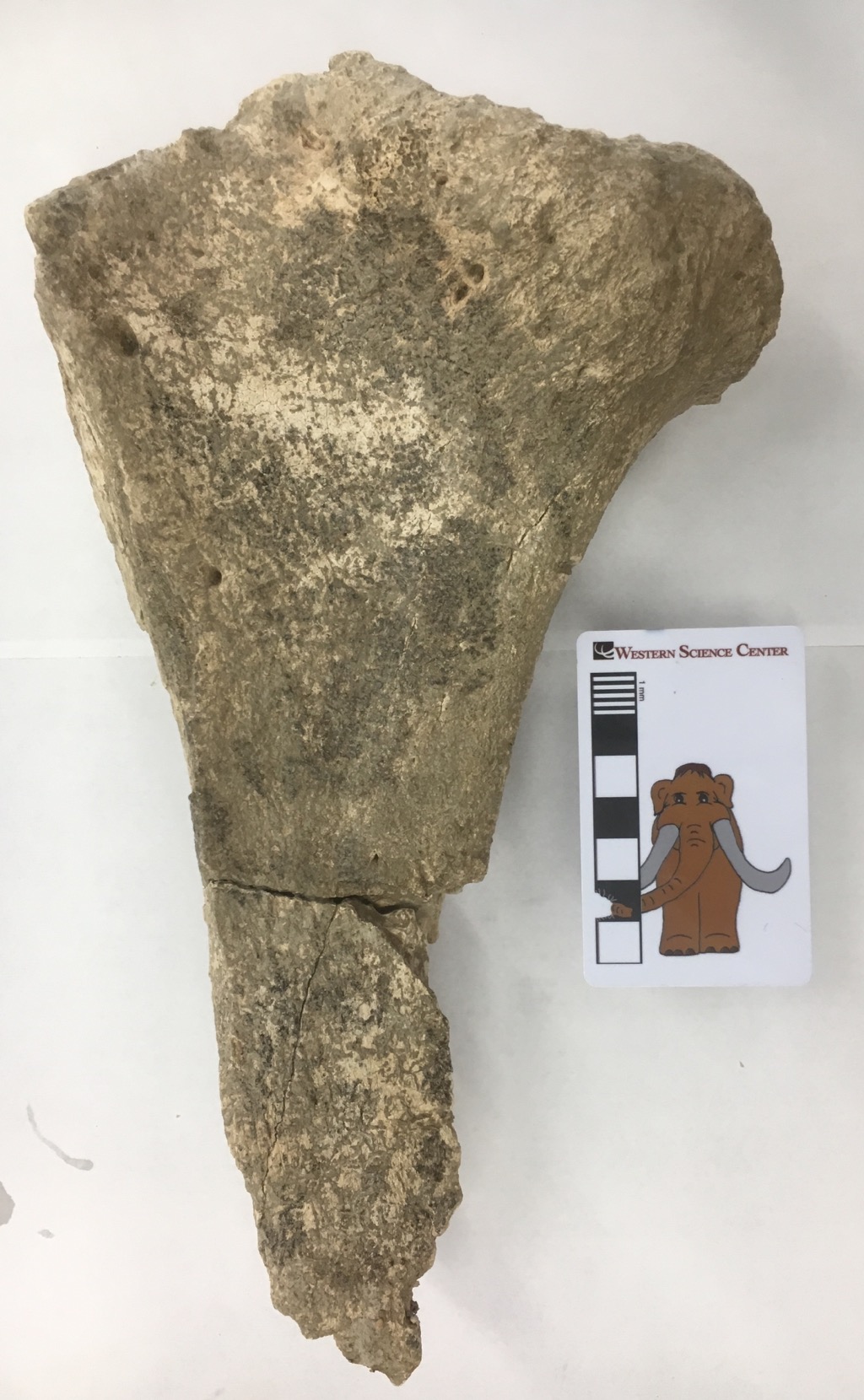 Over the last few weeks we've started pulling a lot of mastodon material from the collections (more on that in a future post). Some of the bones that are turning up are pretty interesting.The large bone fragment shown above is a small part of the proximal end of the right ulna, one of the bones in the forearm. It's shown above in lateral view, and below is looking at the proximal end (part of the articular surface for the elbow):
Over the last few weeks we've started pulling a lot of mastodon material from the collections (more on that in a future post). Some of the bones that are turning up are pretty interesting.The large bone fragment shown above is a small part of the proximal end of the right ulna, one of the bones in the forearm. It's shown above in lateral view, and below is looking at the proximal end (part of the articular surface for the elbow): This fragment is labeled at mastodon, but comparing it to the photos in Olsen (1972) it seems to be closer to a mammoth (below). We'll have to examine it more closely and see if there's any associated material to determine for sure which taxon it belongs to
This fragment is labeled at mastodon, but comparing it to the photos in Olsen (1972) it seems to be closer to a mammoth (below). We'll have to examine it more closely and see if there's any associated material to determine for sure which taxon it belongs to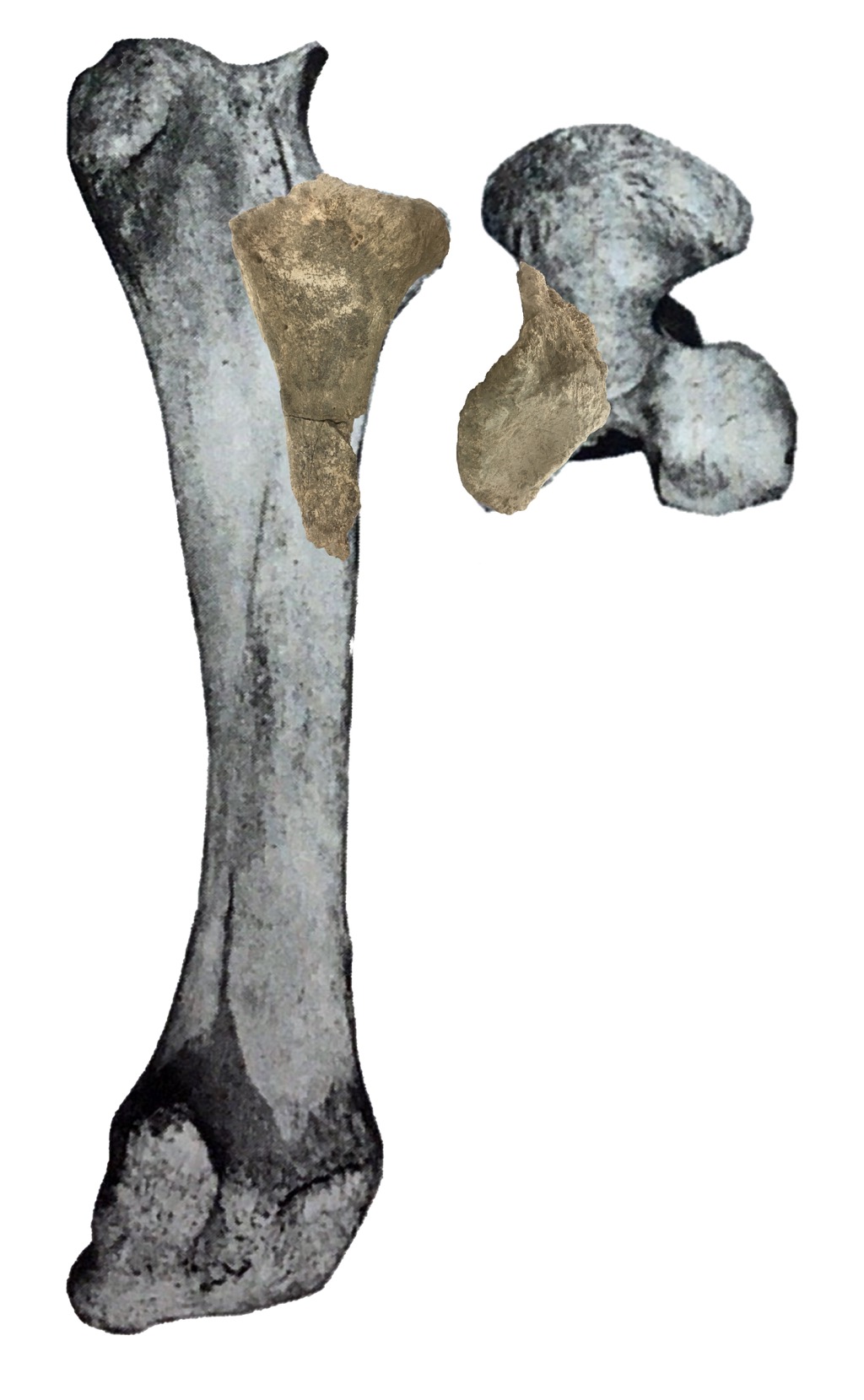 What really caught my attention were details on the edges of the articular surface and a few other places on the bone:
What really caught my attention were details on the edges of the articular surface and a few other places on the bone: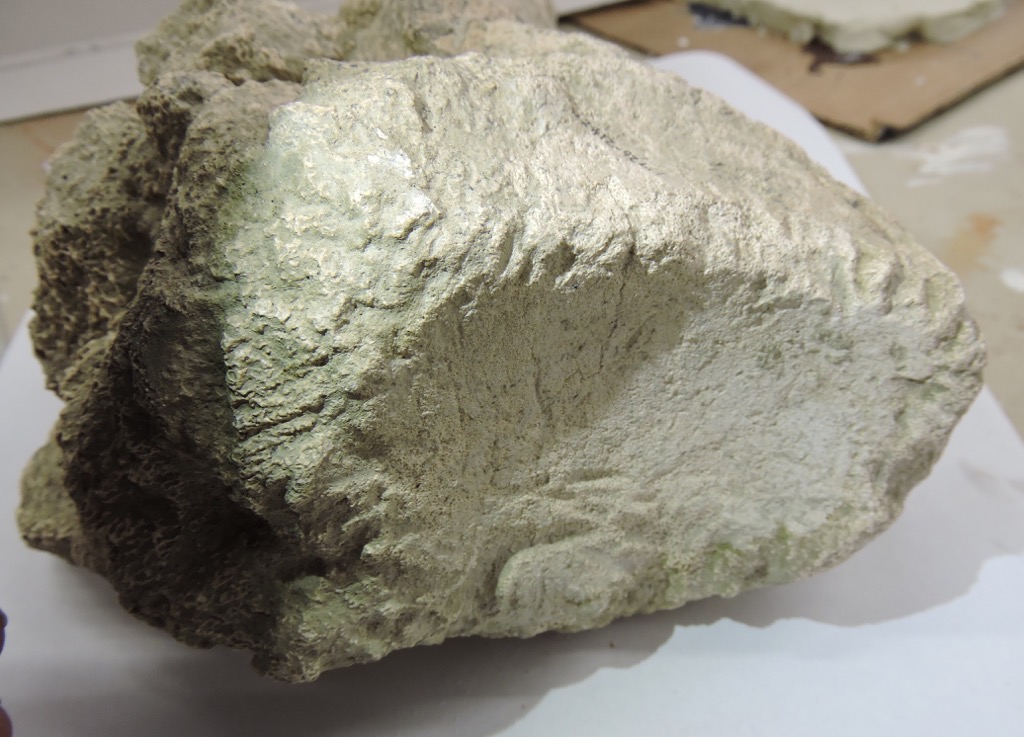
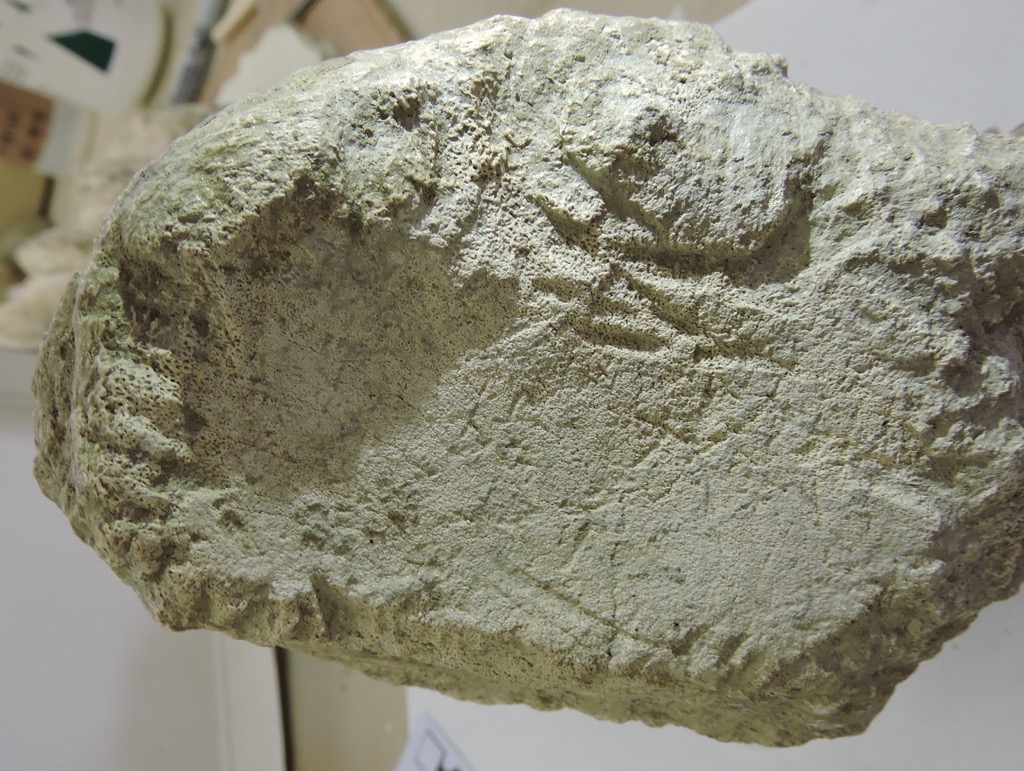
 As we're finding with many of the large bones from Diamond Valley Lake, this bone is covered with bite marks from scavengers, in the form of notches cut into the edges of the bone. These are relatively large grooves, consistent in size with something like a coyote or dire wolf, but there are lots of possibilities.
As we're finding with many of the large bones from Diamond Valley Lake, this bone is covered with bite marks from scavengers, in the form of notches cut into the edges of the bone. These are relatively large grooves, consistent in size with something like a coyote or dire wolf, but there are lots of possibilities.
Reference:Olsen, S. J., 1972. Osteology for the Archaeologist No 3: The American mastodon and Wooly mammoth. Papers of the Peabody Museum of Archaeology and Ethnology, Harvard University 58:1-43.
Crazy dental pathology
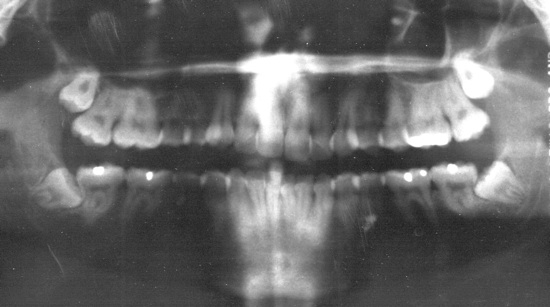 This post was originally published on my old VMNH blog, "Updates from the Paleontology Lab", on March 8, 2010. The post includes anatomical observations that are relevant to human evolution; WSC's exhibit on human origins, "Stepping Out of the Past", is open until May 21.Next week I’m attending the Geological Society of America Northeastern/Southeastern Section meeting, and I’ll be posting daily updates on that conference. Prior to leaving for the conference, I’ll be taking most of this week off. I thought an explanation for my absence is justified, especially as it involves some interesting information about mammal teeth.Nearly all mammals are strongly heterodont, meaning that they have different types of teeth in their mouths. Mammal teeth are typically divided into four groups. From the front of the mouth to the back, these are the incisors, canines, premolars, and molars, respectively abbreviated I, C, P, and M in the upper jaw, and i, c, p, and m in the lower jaw. So, for example, the second upper molar would be M2, while the second lower molar would be m2. Most mammals also have a temporary set of teeth, called milk or deciduous teeth, abbreviated with a “d” prefix (dp1 is the first lower deciduous premolar). Incidentally, some of the terms are different for humans; canines are referred to as eye teeth, premolars as bicuspids, second molars as 12-year teeth, and third molars as wisdom teeth. For some reason, there’s also a convention in humans to refer to the post-canine deciduous teeth as molars rather than as premolars. I’m not sure why this is done, except that these teeth are similar in shape to the permanent molars. They are replaced by the premolars, however, not the molars. Are there any developmental folks out there that can shed some light on this?Anyway, it turns out that tooth counts are pretty significant for determining relationships among different groups of mammals, so there’s also a notation for overall dental formulas. For example:
This post was originally published on my old VMNH blog, "Updates from the Paleontology Lab", on March 8, 2010. The post includes anatomical observations that are relevant to human evolution; WSC's exhibit on human origins, "Stepping Out of the Past", is open until May 21.Next week I’m attending the Geological Society of America Northeastern/Southeastern Section meeting, and I’ll be posting daily updates on that conference. Prior to leaving for the conference, I’ll be taking most of this week off. I thought an explanation for my absence is justified, especially as it involves some interesting information about mammal teeth.Nearly all mammals are strongly heterodont, meaning that they have different types of teeth in their mouths. Mammal teeth are typically divided into four groups. From the front of the mouth to the back, these are the incisors, canines, premolars, and molars, respectively abbreviated I, C, P, and M in the upper jaw, and i, c, p, and m in the lower jaw. So, for example, the second upper molar would be M2, while the second lower molar would be m2. Most mammals also have a temporary set of teeth, called milk or deciduous teeth, abbreviated with a “d” prefix (dp1 is the first lower deciduous premolar). Incidentally, some of the terms are different for humans; canines are referred to as eye teeth, premolars as bicuspids, second molars as 12-year teeth, and third molars as wisdom teeth. For some reason, there’s also a convention in humans to refer to the post-canine deciduous teeth as molars rather than as premolars. I’m not sure why this is done, except that these teeth are similar in shape to the permanent molars. They are replaced by the premolars, however, not the molars. Are there any developmental folks out there that can shed some light on this?Anyway, it turns out that tooth counts are pretty significant for determining relationships among different groups of mammals, so there’s also a notation for overall dental formulas. For example: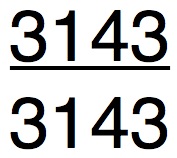 means 3 incisors, 1 canine, 4 premolars, and 3 molars in each half of the upper jaw, and the same count in each half of the lower jaw. This gives a total of 44 teeth in the mouth. This is the primitive tooth count for most placental mammal groups, but most groups have modified this number in the course of their evolution.One of the major divisions in the Order Primates is based largely on tooth counts. The Platyrrhini, or New World monkeys, have a tooth count of:
means 3 incisors, 1 canine, 4 premolars, and 3 molars in each half of the upper jaw, and the same count in each half of the lower jaw. This gives a total of 44 teeth in the mouth. This is the primitive tooth count for most placental mammal groups, but most groups have modified this number in the course of their evolution.One of the major divisions in the Order Primates is based largely on tooth counts. The Platyrrhini, or New World monkeys, have a tooth count of: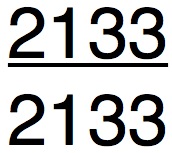 while the Catarrhini, or Old World monkeys, gibbons, and apes, have a count of:
while the Catarrhini, or Old World monkeys, gibbons, and apes, have a count of: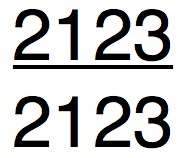 All the catarrhines share this count, going back to the Late Eocene or Early Oligocene. Here’s the Early Miocene Proconsul (specimen from AMNH):
All the catarrhines share this count, going back to the Late Eocene or Early Oligocene. Here’s the Early Miocene Proconsul (specimen from AMNH):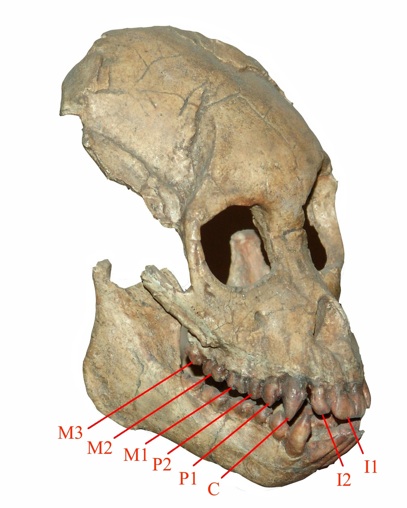 And here’s a modern Gorilla (photo taken at the Henry Doorly Zoo):
And here’s a modern Gorilla (photo taken at the Henry Doorly Zoo): Humans, as catorrhines, have the same tooth count, as is apparent in Brett’s dental X-rays:
Humans, as catorrhines, have the same tooth count, as is apparent in Brett’s dental X-rays: Notice, however, the unusual position of the upper and lower third molars (M3 and m3). These are the wisdom teeth, and as is commonly the case in humans, they are impacted (growing into the side of the adjacent teeth). Impacted wisdom teeth can cause pain and infection, and are often surgically removed. This is a relict of humans’ evolutionary history; as the only short-snouted catarrhines, there isn’t room in our mouths for the third molar. In fact, other dental abnormalities are fairly common in humans, probably due to the same developmental issues, which brings me to my absence from work later this week.These are my son Tim’s dental X-rays, taken just before his 12th birthday:
Notice, however, the unusual position of the upper and lower third molars (M3 and m3). These are the wisdom teeth, and as is commonly the case in humans, they are impacted (growing into the side of the adjacent teeth). Impacted wisdom teeth can cause pain and infection, and are often surgically removed. This is a relict of humans’ evolutionary history; as the only short-snouted catarrhines, there isn’t room in our mouths for the third molar. In fact, other dental abnormalities are fairly common in humans, probably due to the same developmental issues, which brings me to my absence from work later this week.These are my son Tim’s dental X-rays, taken just before his 12th birthday: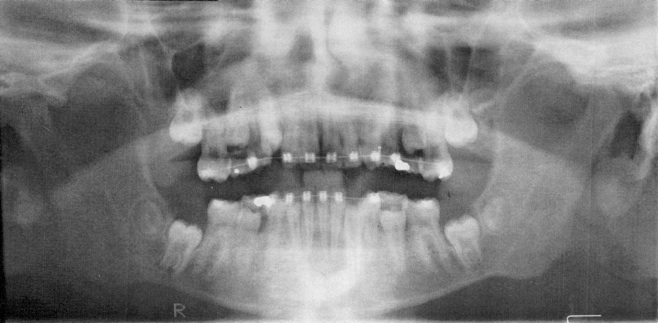 There’s a lot going on in this image. The bright objects are braces, and two fillings. Here’s the same image, with the teeth labeled:
There’s a lot going on in this image. The bright objects are braces, and two fillings. Here’s the same image, with the teeth labeled: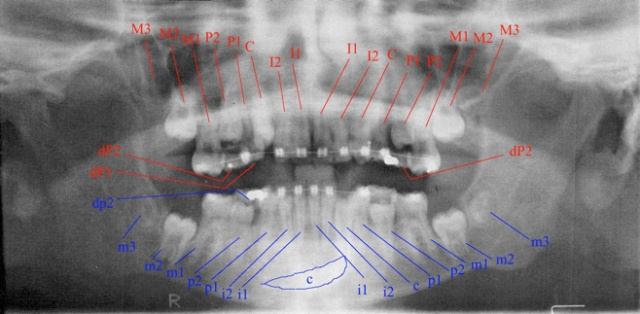 Note that the image is reversed (right is on the left). There are four or five deciduous teeth still in place (four are labeled), although the permanent teeth have formed beneath them. It’s also clear that the M2’s and m2’s (the 12-year teeth) have formed but not yet erupted, and the third molars are just starting to develop (left m3 seems a little further along than the others). There is a lot of crowding (human developmental issues, again!) that has prevented the canines from erupting normally, which is why the braces were needed.The big problem is in the middle of the lower jaw, that blue-outlined area labeled “c”. That’s the right lower canine, and it’s completely out of position. It has rotated almost 90 degrees, and is laying across the mandibular symphysis with its crown sitting underneath the left lower canine.Here’s a follow-up X-ray from 13 months later:
Note that the image is reversed (right is on the left). There are four or five deciduous teeth still in place (four are labeled), although the permanent teeth have formed beneath them. It’s also clear that the M2’s and m2’s (the 12-year teeth) have formed but not yet erupted, and the third molars are just starting to develop (left m3 seems a little further along than the others). There is a lot of crowding (human developmental issues, again!) that has prevented the canines from erupting normally, which is why the braces were needed.The big problem is in the middle of the lower jaw, that blue-outlined area labeled “c”. That’s the right lower canine, and it’s completely out of position. It has rotated almost 90 degrees, and is laying across the mandibular symphysis with its crown sitting underneath the left lower canine.Here’s a follow-up X-ray from 13 months later: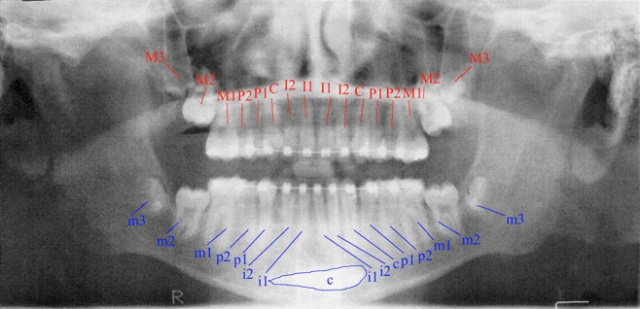 The improvement is remarkable. The deciduous teeth are all gone, and the spacing is a little better. The third molars are more developed, but it appears they’ll be impacted and eventually need to be removed. With the extra space, three of the canines have been able to grow in normally. Unfortunately, that lower right canine has actually gotten worse. It’s now in a position where it can cause damage to the nerves and vessels supplying all the lower incisors and the other canine, and will have to be removed through fairly invasive surgery. Tim will be having that surgery this week, and I’ve decided to take off Wednesday and Thursday while he recovers.Of course, with a missing tooth Tim could eventually have occlusion problems which could cause rapid and abnormal wear on his teeth, like what happened to the Rappahannock River sperm whale (note the massive wear facets on the two teeth on the right):
The improvement is remarkable. The deciduous teeth are all gone, and the spacing is a little better. The third molars are more developed, but it appears they’ll be impacted and eventually need to be removed. With the extra space, three of the canines have been able to grow in normally. Unfortunately, that lower right canine has actually gotten worse. It’s now in a position where it can cause damage to the nerves and vessels supplying all the lower incisors and the other canine, and will have to be removed through fairly invasive surgery. Tim will be having that surgery this week, and I’ve decided to take off Wednesday and Thursday while he recovers.Of course, with a missing tooth Tim could eventually have occlusion problems which could cause rapid and abnormal wear on his teeth, like what happened to the Rappahannock River sperm whale (note the massive wear facets on the two teeth on the right):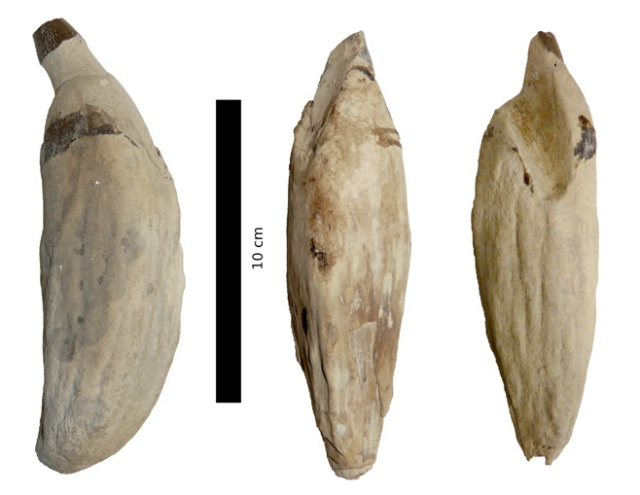 To avoid this problem, Tim’s braces have been used to open a gap between the right i2 and p1 (not visible in these photos), where the canine should be. An artificial tooth will fill this gap, to help ensure proper occlusion between his upper and lower teeth.Shortly after the original post was written, Tim successfully had the problematic canine removed.
To avoid this problem, Tim’s braces have been used to open a gap between the right i2 and p1 (not visible in these photos), where the canine should be. An artificial tooth will fill this gap, to help ensure proper occlusion between his upper and lower teeth.Shortly after the original post was written, Tim successfully had the problematic canine removed.
Fossil Friday - pea clam
 While the Diamond Valley Lake fossil fauna is best known for its mammals, there were also thousands of mollusks recovered. These are mostly minute freshwater species, and even though we have thousands of them the all fit easily in a single specimen case.While most of these mollusks are gastropods (snails), there are some bivalves as well. Above is the right valve of a pea clam, Pisidium, shown in lateral or exterior view. The alternating black and white lines in the background are each 1 mm wide. Below is the same shell in interior view:
While the Diamond Valley Lake fossil fauna is best known for its mammals, there were also thousands of mollusks recovered. These are mostly minute freshwater species, and even though we have thousands of them the all fit easily in a single specimen case.While most of these mollusks are gastropods (snails), there are some bivalves as well. Above is the right valve of a pea clam, Pisidium, shown in lateral or exterior view. The alternating black and white lines in the background are each 1 mm wide. Below is the same shell in interior view: The shell's hinge, where the left valve would have attached, is visible along the lower left margin of the shell. Inside the shell, you can just make out the adductor scar; this is the attachment point for the muscles that close the shell.As I've been discovering, it's difficult to find a lot of information online about freshwater mollusks. Pisidium is a widespread extant genus, found in (at least) Eurasia, Africa, and North America. It appears that many of the modern species found in North America are invasive species from Europe, but clearly the genus was present here long before the arrival of Europeans.
The shell's hinge, where the left valve would have attached, is visible along the lower left margin of the shell. Inside the shell, you can just make out the adductor scar; this is the attachment point for the muscles that close the shell.As I've been discovering, it's difficult to find a lot of information online about freshwater mollusks. Pisidium is a widespread extant genus, found in (at least) Eurasia, Africa, and North America. It appears that many of the modern species found in North America are invasive species from Europe, but clearly the genus was present here long before the arrival of Europeans.
Fossil Friday - partial mastodon skeleton
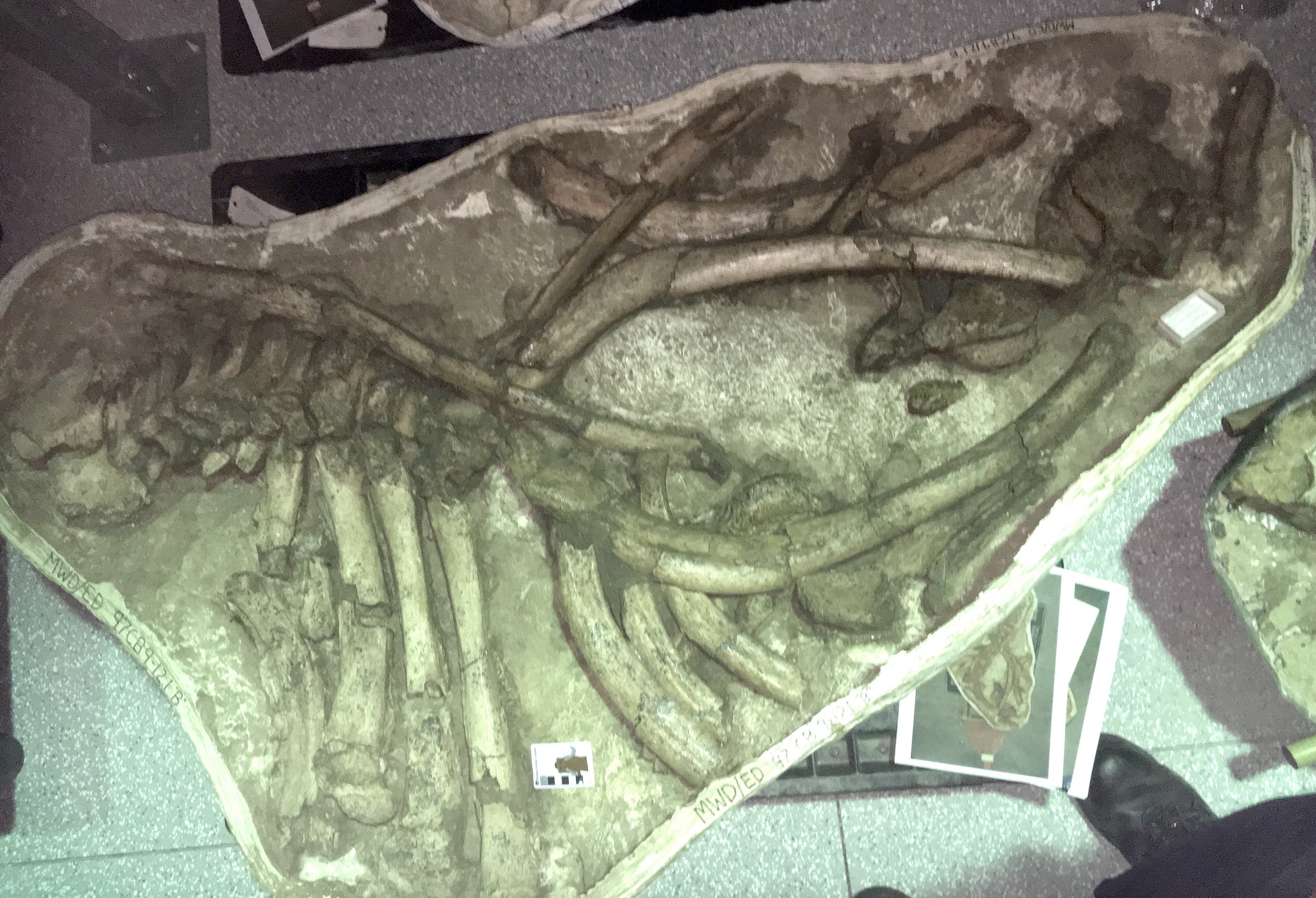 California mastodons have been in the news lately, so I decided to go with one of our Diamond Valley Lake mastodons for Fossil Friday this week.The specimen shown above is a partially articulated skeleton from the East Dam of the lake, making it among our older mastodon skeletons (likely at least 35,000 years old). In the marked version below, vertebrae are highlighted in blue:
California mastodons have been in the news lately, so I decided to go with one of our Diamond Valley Lake mastodons for Fossil Friday this week.The specimen shown above is a partially articulated skeleton from the East Dam of the lake, making it among our older mastodon skeletons (likely at least 35,000 years old). In the marked version below, vertebrae are highlighted in blue: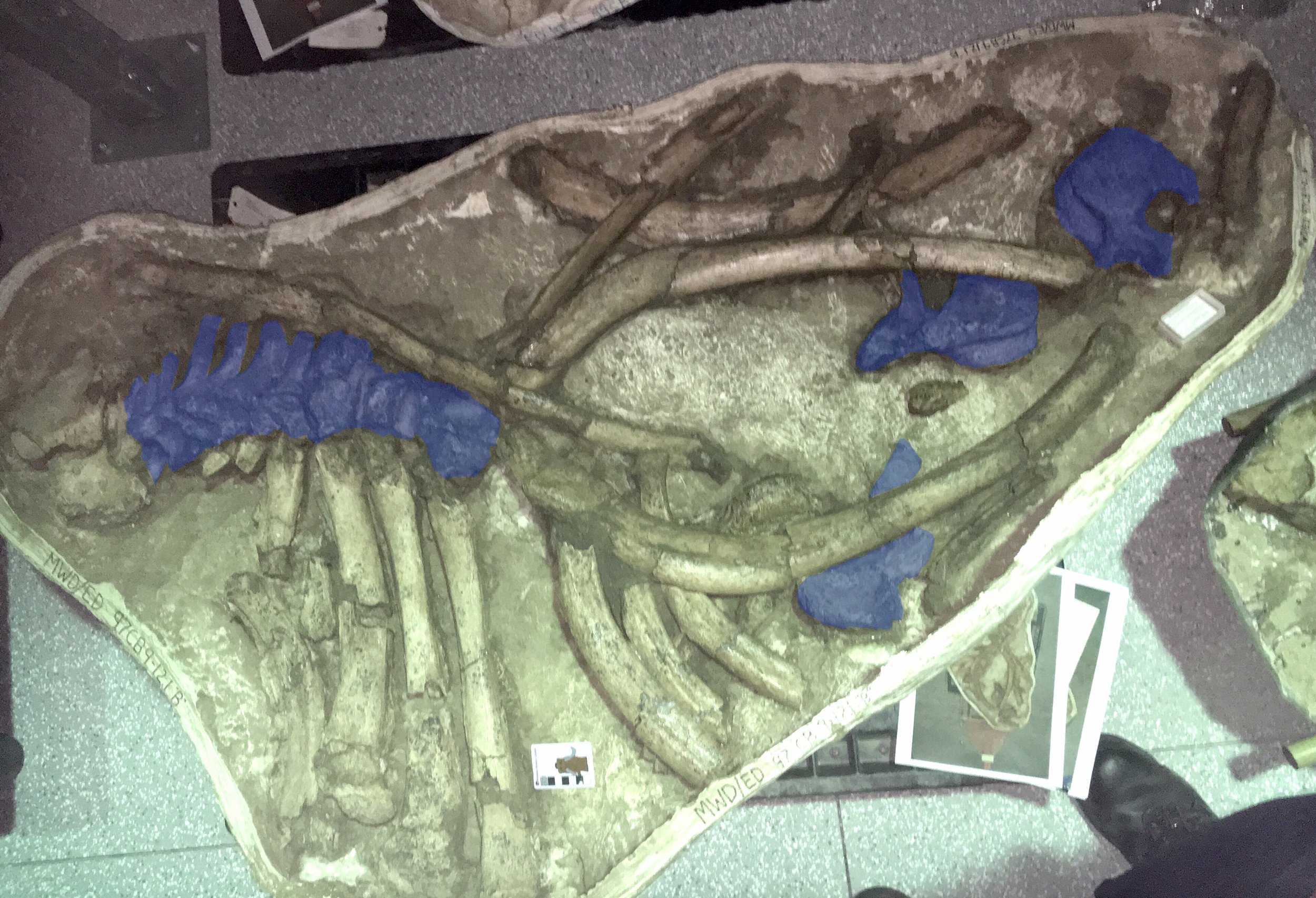 The anterior end of the skeleton is to the left. The anterior end of the thoracic region is still pretty well articulated (it's possible this may include the last few cervical vertebrae, but confirming this will require closer examination). Further back, on the right, the skeleton becomes more scattered, and it appears a number of vertebrae are missing. The vertebra in the upper right corner is especially interesting; a closeup is below:
The anterior end of the skeleton is to the left. The anterior end of the thoracic region is still pretty well articulated (it's possible this may include the last few cervical vertebrae, but confirming this will require closer examination). Further back, on the right, the skeleton becomes more scattered, and it appears a number of vertebrae are missing. The vertebra in the upper right corner is especially interesting; a closeup is below: The rectangular vertebral centrum is typical of the posterior thoracic and lumbar vertebrae in mastodons, and is quite different from the centrum shape in mammoths (which are taller and more pointed at the bottom), confirming the identity of this specimen as a mastodon.At least one of the ribs has notches along the margin that are consistent with marks caused by gnawing rodents:
The rectangular vertebral centrum is typical of the posterior thoracic and lumbar vertebrae in mastodons, and is quite different from the centrum shape in mammoths (which are taller and more pointed at the bottom), confirming the identity of this specimen as a mastodon.At least one of the ribs has notches along the margin that are consistent with marks caused by gnawing rodents: Of course, the big media news this week was a report (Holen et al. 2017) of a 130,000-year-old mastodon from San Diego that was supposedly worked by humans, more than 100,000 years before humans were thought to have arrived in North America. I have read the paper and I'm currently reading the supplemental material. The paper is quite detailed, and while I'm impressed with their arguments I remain unconvinced of their interpretation. While I feel the age is likely correct, I question their interpretation that the damage seen on the bones could only have been caused by humans; there needs to be a much better demonstration that human activity is the only reasonable explanation for their observations. Human teeth, cranial bones, jaws, vertebrae, and limb elements are all easily identified, yet no scrap of human bone has turned up even in areas with extensive collections such as Diamond Valley Lake, even in 30-40,000 year old sediments that are young enough to date using C14. For what i's worth, while a few people have suggested otherwise, I see no eveidence of any human working of the Pleistocene bones from Diamond Valley Lake, and there's no evidence of human habitation from the Valley during the Ice Age, even though there are extensive archaeological remains in the Valley that post-date the Ice Age.
Of course, the big media news this week was a report (Holen et al. 2017) of a 130,000-year-old mastodon from San Diego that was supposedly worked by humans, more than 100,000 years before humans were thought to have arrived in North America. I have read the paper and I'm currently reading the supplemental material. The paper is quite detailed, and while I'm impressed with their arguments I remain unconvinced of their interpretation. While I feel the age is likely correct, I question their interpretation that the damage seen on the bones could only have been caused by humans; there needs to be a much better demonstration that human activity is the only reasonable explanation for their observations. Human teeth, cranial bones, jaws, vertebrae, and limb elements are all easily identified, yet no scrap of human bone has turned up even in areas with extensive collections such as Diamond Valley Lake, even in 30-40,000 year old sediments that are young enough to date using C14. For what i's worth, while a few people have suggested otherwise, I see no eveidence of any human working of the Pleistocene bones from Diamond Valley Lake, and there's no evidence of human habitation from the Valley during the Ice Age, even though there are extensive archaeological remains in the Valley that post-date the Ice Age.
Fossil Friday - possible bobcat tooth
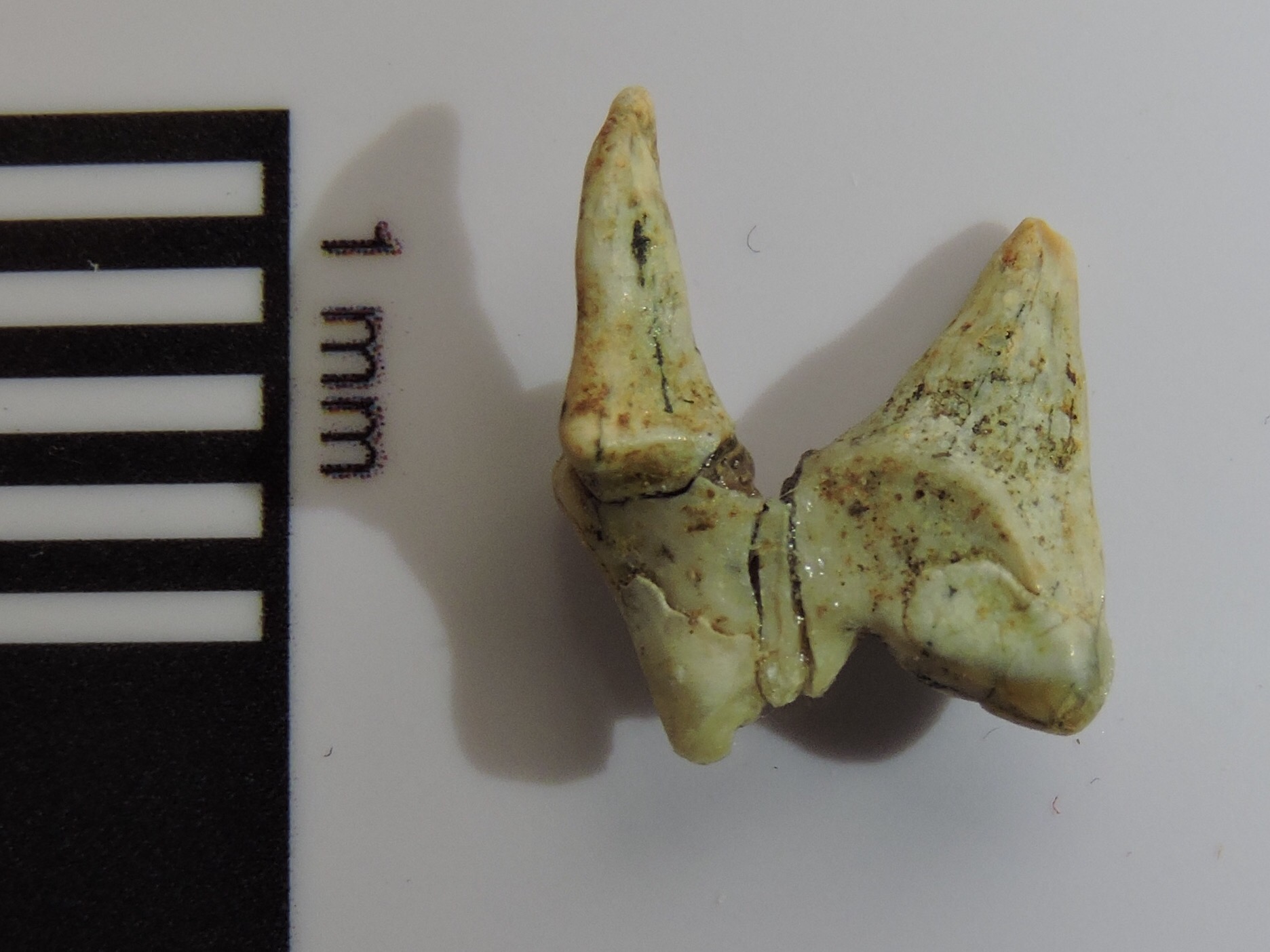 Confession time: I'm not an expert on most of the organisms I feature on Fossil Friday, and it sometimes takes me a fair bit of research to work out what I'm going to say. Because of that, when I'm swamped with other work (like this week), I will usually pick a Fossil Friday specimen that is straightforward so that I can write about it quickly. But sometimes the choice backfires.One of the rarest fossils from Diamond Valley Lake is the bobcat, represented by a single tooth and possibly two other bones. Confirming the identity of a bobcat tooth should be relatively straightforward, especially since we recently acquired a modern bobcat skull for comparison. Our database indicated that the single tooth is a lower first molar, broken into three fragments. In carnivorans such as cats, the lower 1st molar is modified into a large blade-shaped tooth. The upper 4th premolar is modified in a similar way, and these two teeth (called the carnassials) occlude like a pair of scissors, slicing up meat. A quick glance at the three tooth fragments confirmed that the carnassial blade structure was present. As long as I had the tooth out, I decided to glue the fragments back together, with the result shown above in lingual view and below in labial view.
Confession time: I'm not an expert on most of the organisms I feature on Fossil Friday, and it sometimes takes me a fair bit of research to work out what I'm going to say. Because of that, when I'm swamped with other work (like this week), I will usually pick a Fossil Friday specimen that is straightforward so that I can write about it quickly. But sometimes the choice backfires.One of the rarest fossils from Diamond Valley Lake is the bobcat, represented by a single tooth and possibly two other bones. Confirming the identity of a bobcat tooth should be relatively straightforward, especially since we recently acquired a modern bobcat skull for comparison. Our database indicated that the single tooth is a lower first molar, broken into three fragments. In carnivorans such as cats, the lower 1st molar is modified into a large blade-shaped tooth. The upper 4th premolar is modified in a similar way, and these two teeth (called the carnassials) occlude like a pair of scissors, slicing up meat. A quick glance at the three tooth fragments confirmed that the carnassial blade structure was present. As long as I had the tooth out, I decided to glue the fragments back together, with the result shown above in lingual view and below in labial view. The tooth still shows a lot of damage, but one thing that was immediately clear was that the tooth originally had three roots; that meant it was an upper tooth. Instead of a lower left 1st molar, it's actually an upper right 4th premolar. Here's an occlusal view of the tooth:
The tooth still shows a lot of damage, but one thing that was immediately clear was that the tooth originally had three roots; that meant it was an upper tooth. Instead of a lower left 1st molar, it's actually an upper right 4th premolar. Here's an occlusal view of the tooth: The knob projecting to the upper right (toward the front and middling of the skull, or "anterolingually") is called the protocone. A root is located directly under the protocone. The protocone and its associated root were broken off as a separate piece, which I suspect is what caused the misidentification.So, now that the tooth is an upper 4th premolar instead of a lower 1st molar, can we still call it a bobcat? Unfortunately, that's not entirely clear. Below is an occlusal view of a bobcat's upper 4th premolar:
The knob projecting to the upper right (toward the front and middling of the skull, or "anterolingually") is called the protocone. A root is located directly under the protocone. The protocone and its associated root were broken off as a separate piece, which I suspect is what caused the misidentification.So, now that the tooth is an upper 4th premolar instead of a lower 1st molar, can we still call it a bobcat? Unfortunately, that's not entirely clear. Below is an occlusal view of a bobcat's upper 4th premolar: While these teeth are similar in some ways, there are some important differences. For example, the lingual edge of the tooth is slightly convex in the bobcat, but slightly concave in the DVL specimen. The bobcat tooth is also about 10% larger.In terms of size, the DVL tooth is actually closer to a gray fox:
While these teeth are similar in some ways, there are some important differences. For example, the lingual edge of the tooth is slightly convex in the bobcat, but slightly concave in the DVL specimen. The bobcat tooth is also about 10% larger.In terms of size, the DVL tooth is actually closer to a gray fox: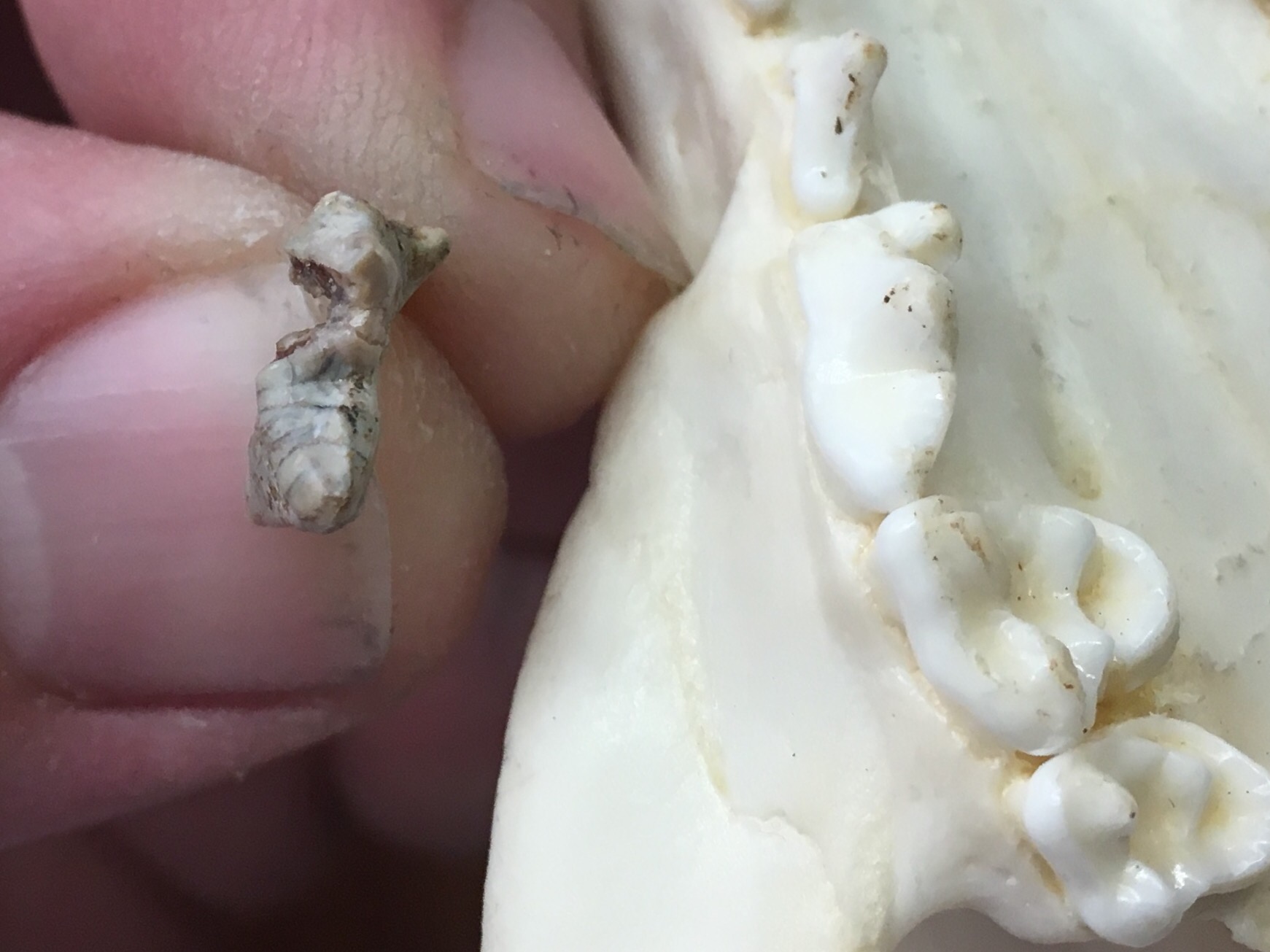 While the size is good, the shape of the DVL tooth still differs quite a bit from the gray fox, particularly the shape of the anterior edge. On balance, in spite of the size, I think this tooth is still more similar to a bobcat than anything else I've seen. Until we can study it further, I think we can tentatively call it a bobcat.
While the size is good, the shape of the DVL tooth still differs quite a bit from the gray fox, particularly the shape of the anterior edge. On balance, in spite of the size, I think this tooth is still more similar to a bobcat than anything else I've seen. Until we can study it further, I think we can tentatively call it a bobcat.
Fossil Friday - possible mastodon bones
 A common theme on this blog is that we can often get a lot of information from very incomplete material. Even so, as a general rule, the more remains we have from a given fossil organism, the more we can say about it. But sometimes we can have multiple bones, and even something as basic as a species identification can be elusive.The small field jacket shown above was collected from the West Dam of Diamond Valley Lake. There are several bones present, all consistent with a single individual. An annotated version is shown below:
A common theme on this blog is that we can often get a lot of information from very incomplete material. Even so, as a general rule, the more remains we have from a given fossil organism, the more we can say about it. But sometimes we can have multiple bones, and even something as basic as a species identification can be elusive.The small field jacket shown above was collected from the West Dam of Diamond Valley Lake. There are several bones present, all consistent with a single individual. An annotated version is shown below: The bone highlighted in blue is the distal end of the left femur. Those in red are ribs, the yellow are thoracic vertebrae, and the purple are unidentified. The size and general shape indicate that these are proboscidean bones, but there are two species from Diamond Valley Lake: the mammoth Mammuthus columbi and the mastodon Mammut americanum. While mastodons are much more common at DVL, numerous mammoth remains were also found. Which species is represented by these bones?Obviously our unidentified bones are not going to be of much help here. Ribs are also notoriously difficult to identify, especially if they're incomplete.The femur is potentially more useful. Femora have lots of distinctive features, and they differ between mammoths and mastodons. The most obvious difference is that mastodon femora are much more robust, while mammoth femora are rather long and slender. Unfortunately, this is difficult to evaluate unless a substantial portion of the femur (roughly half) is preserved. We only have about the distal fourth of the femur, and that is poorly preserved and partially hidden under the other bones. The medial condyle (the large curved knob at the end of the femur) does seem quite large, and this may suggest that a mastodon is more likely, but that's not much to go on.How about the vertebrae? In most vertebral positions mammoth and mastodon vertebrae are quite different. For example, in anterior view the lumbar vertebrae of mastodons have nearly rectangular centra that are wider than tall, while in mammoths they are more heart-shaped and are taller than wide. These vertebrae appear to be posterior thoracic vertebrae. Unfortunately, mammoth and mastodon posterior thoracics are very similar to each other. Mammoths tend to have much longer neural spines on these vertebrae, but the spines are incomplete in this specimen. Mastodons have a slightly taller and differently shaped neural canal, that seems a little more similar to these bones, but it seems this trait is quite variable.The only other hint may be the size. By proboscidean standards, these bones are not particularly large. Even though they're fairly small, they come from a more-or-less adult animal; the condyles are fused to the femur, and the vertebral epiphyses are fused to their centra, both of which indicate an animal that was mostly finished growing. Mammoths were larger than mastodons on average, so that suggests that a mastodon might be more likely (and, of course, mastodons are three times more common at DVL than mammoths).So, which is it? I don't know. I lean toward mastodon, and most of the observations seem to point that way, but that's with a lot of "mays", "seems", "suggests", and other tentative qualifiers. Sometimes, it's hard to say for sure.
The bone highlighted in blue is the distal end of the left femur. Those in red are ribs, the yellow are thoracic vertebrae, and the purple are unidentified. The size and general shape indicate that these are proboscidean bones, but there are two species from Diamond Valley Lake: the mammoth Mammuthus columbi and the mastodon Mammut americanum. While mastodons are much more common at DVL, numerous mammoth remains were also found. Which species is represented by these bones?Obviously our unidentified bones are not going to be of much help here. Ribs are also notoriously difficult to identify, especially if they're incomplete.The femur is potentially more useful. Femora have lots of distinctive features, and they differ between mammoths and mastodons. The most obvious difference is that mastodon femora are much more robust, while mammoth femora are rather long and slender. Unfortunately, this is difficult to evaluate unless a substantial portion of the femur (roughly half) is preserved. We only have about the distal fourth of the femur, and that is poorly preserved and partially hidden under the other bones. The medial condyle (the large curved knob at the end of the femur) does seem quite large, and this may suggest that a mastodon is more likely, but that's not much to go on.How about the vertebrae? In most vertebral positions mammoth and mastodon vertebrae are quite different. For example, in anterior view the lumbar vertebrae of mastodons have nearly rectangular centra that are wider than tall, while in mammoths they are more heart-shaped and are taller than wide. These vertebrae appear to be posterior thoracic vertebrae. Unfortunately, mammoth and mastodon posterior thoracics are very similar to each other. Mammoths tend to have much longer neural spines on these vertebrae, but the spines are incomplete in this specimen. Mastodons have a slightly taller and differently shaped neural canal, that seems a little more similar to these bones, but it seems this trait is quite variable.The only other hint may be the size. By proboscidean standards, these bones are not particularly large. Even though they're fairly small, they come from a more-or-less adult animal; the condyles are fused to the femur, and the vertebral epiphyses are fused to their centra, both of which indicate an animal that was mostly finished growing. Mammoths were larger than mastodons on average, so that suggests that a mastodon might be more likely (and, of course, mastodons are three times more common at DVL than mammoths).So, which is it? I don't know. I lean toward mastodon, and most of the observations seem to point that way, but that's with a lot of "mays", "seems", "suggests", and other tentative qualifiers. Sometimes, it's hard to say for sure.
Fossil Friday - mammoth tooth
 With the influence of Max Mastodon, Diamond Valley Lake mammoths sometimes get short shrift around here. But while DVL mammoths are not nearly as common as mastodons, there is still plenty of interesting mammoth material.The tooth shown above is an upper molar, probably the second molar, with the anterior end of the tooth to the right. This is the occlusal view showing the transverse enamel ridges that are typical of mammoths and other members of the family Elephantidae, including the modern elephants. (Mastodons are proboscideans, but not elephantids, which is reflected in their different tooth structure.) Below is a medial view, with anterior to the left:
With the influence of Max Mastodon, Diamond Valley Lake mammoths sometimes get short shrift around here. But while DVL mammoths are not nearly as common as mastodons, there is still plenty of interesting mammoth material.The tooth shown above is an upper molar, probably the second molar, with the anterior end of the tooth to the right. This is the occlusal view showing the transverse enamel ridges that are typical of mammoths and other members of the family Elephantidae, including the modern elephants. (Mastodons are proboscideans, but not elephantids, which is reflected in their different tooth structure.) Below is a medial view, with anterior to the left: Because mammoths (like other advanced proboscideans) had horizontal tooth replacement, the anterior end of the tooth erupts first, with the upper teeth moving forward and down over time. That means the front of the tooth has seen more use than the back of the tooth, which is clear in medial view. The front of the tooth is very short because it has been almost completely worn away, while the back of the tooth is still tall, with very little wear.This specimen, which was associated with another tooth and several other cranial fragments, was recovered from near the East Dam of Diamond Valley Lake. Most of the dated sediments from that end of the lake are among the older DVL deposits, from about 35,000 to 45,000 years old.
Because mammoths (like other advanced proboscideans) had horizontal tooth replacement, the anterior end of the tooth erupts first, with the upper teeth moving forward and down over time. That means the front of the tooth has seen more use than the back of the tooth, which is clear in medial view. The front of the tooth is very short because it has been almost completely worn away, while the back of the tooth is still tall, with very little wear.This specimen, which was associated with another tooth and several other cranial fragments, was recovered from near the East Dam of Diamond Valley Lake. Most of the dated sediments from that end of the lake are among the older DVL deposits, from about 35,000 to 45,000 years old.

